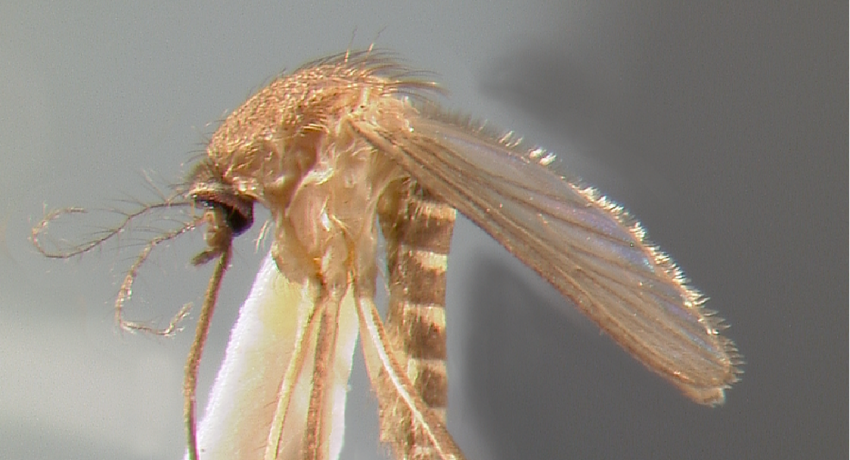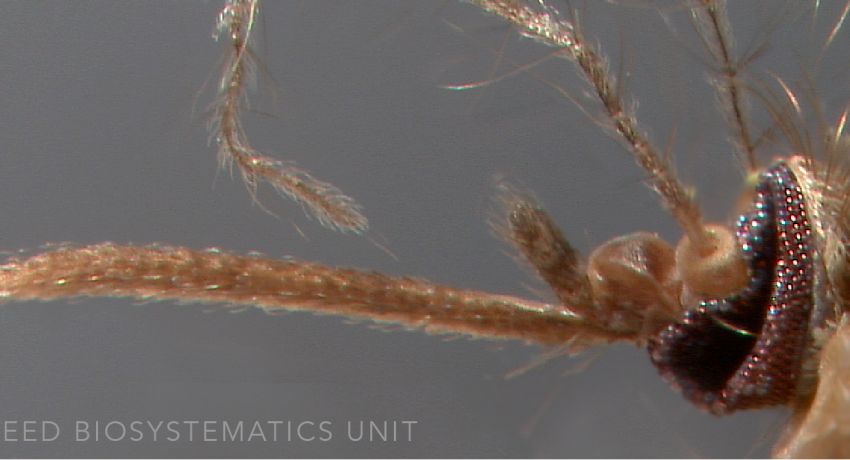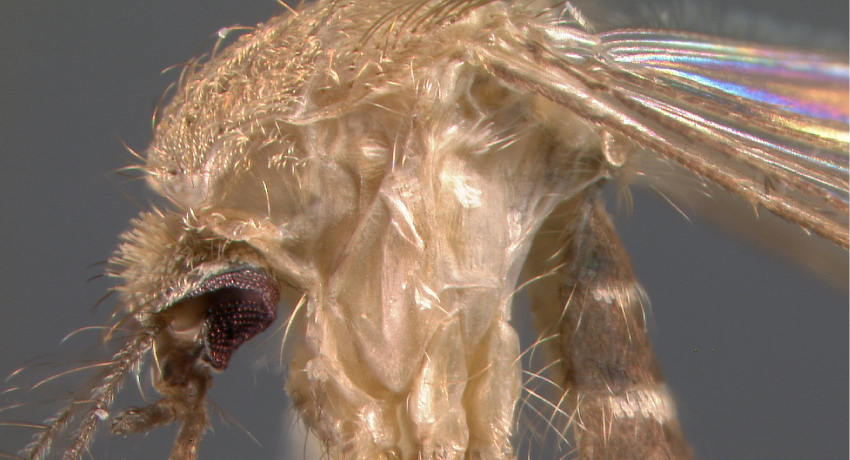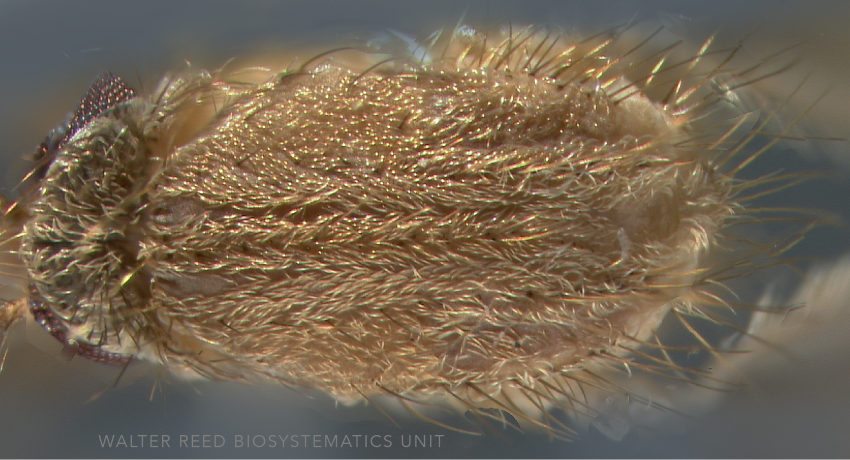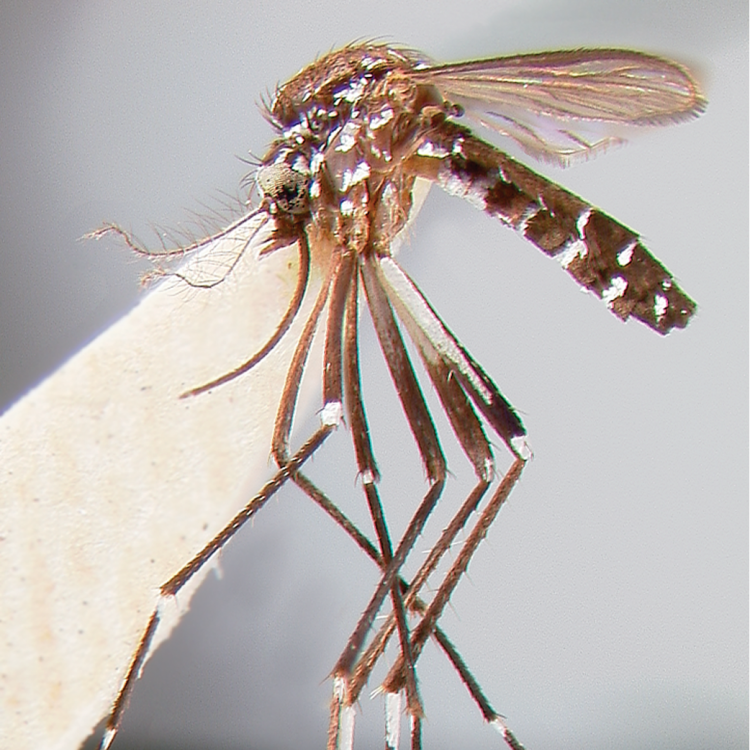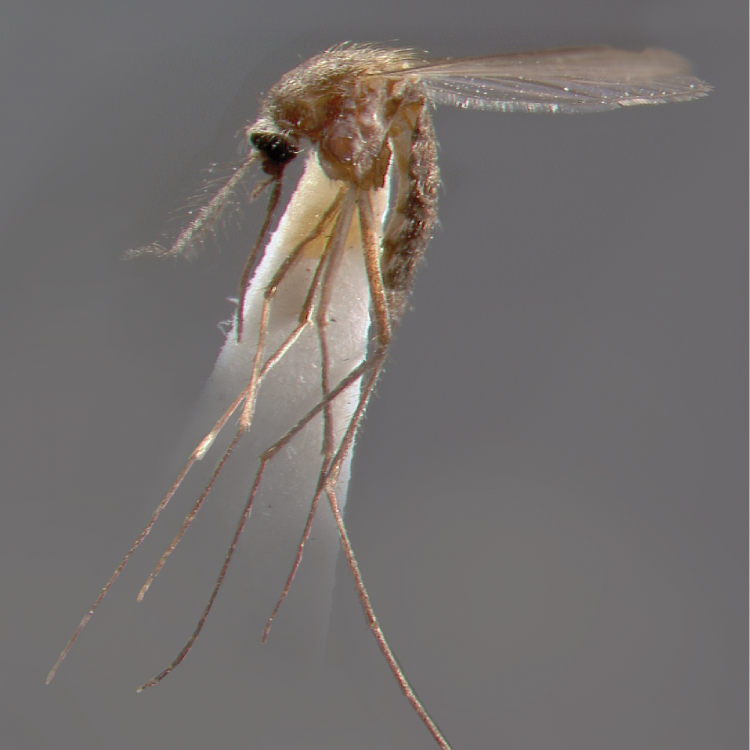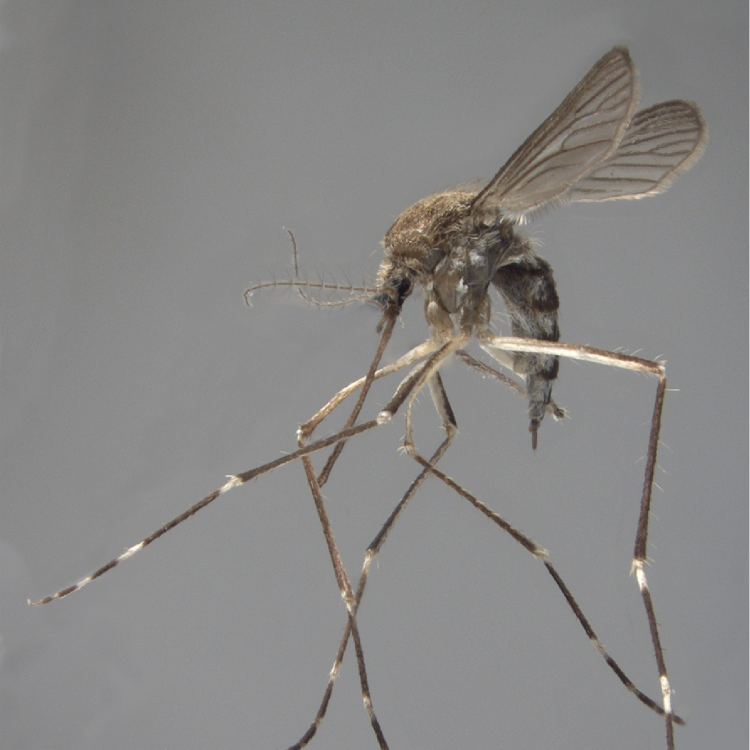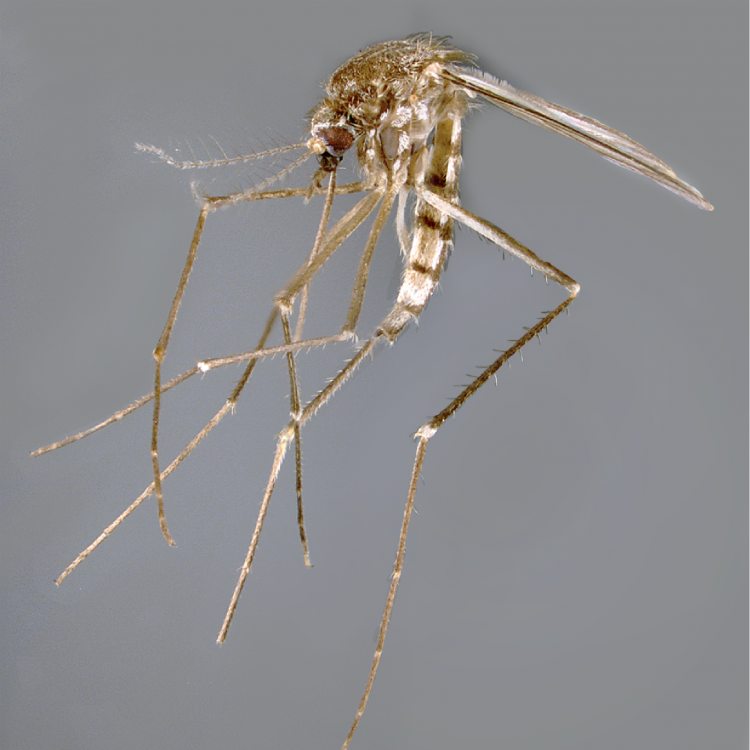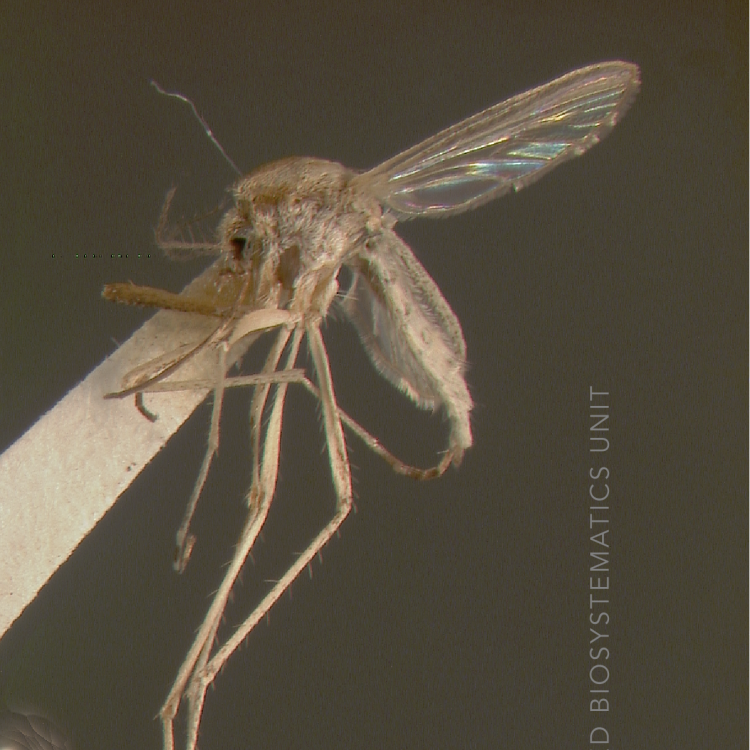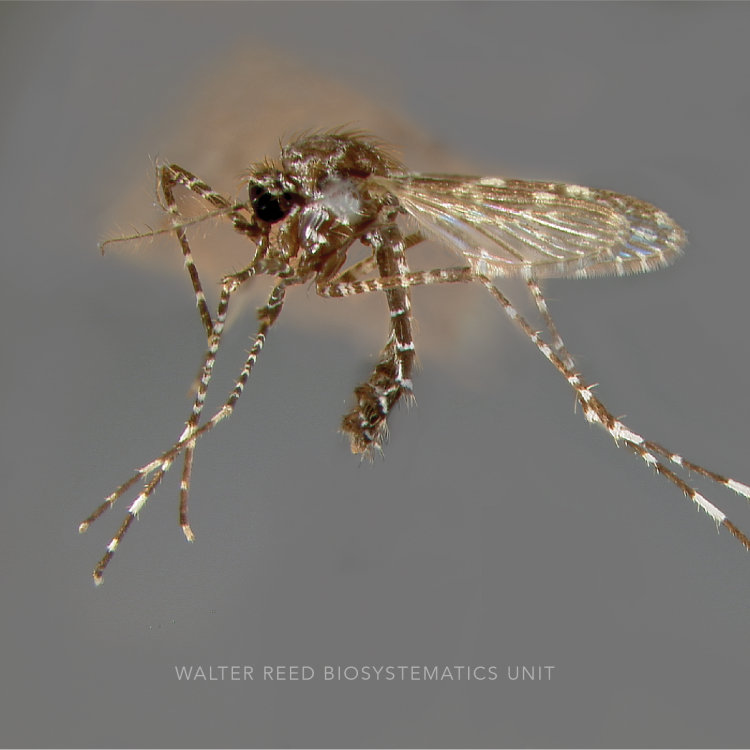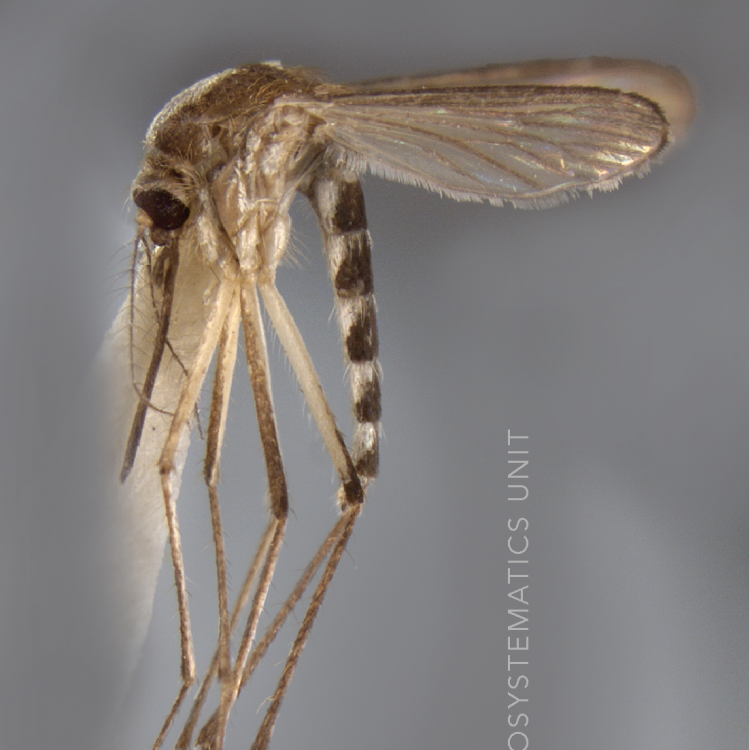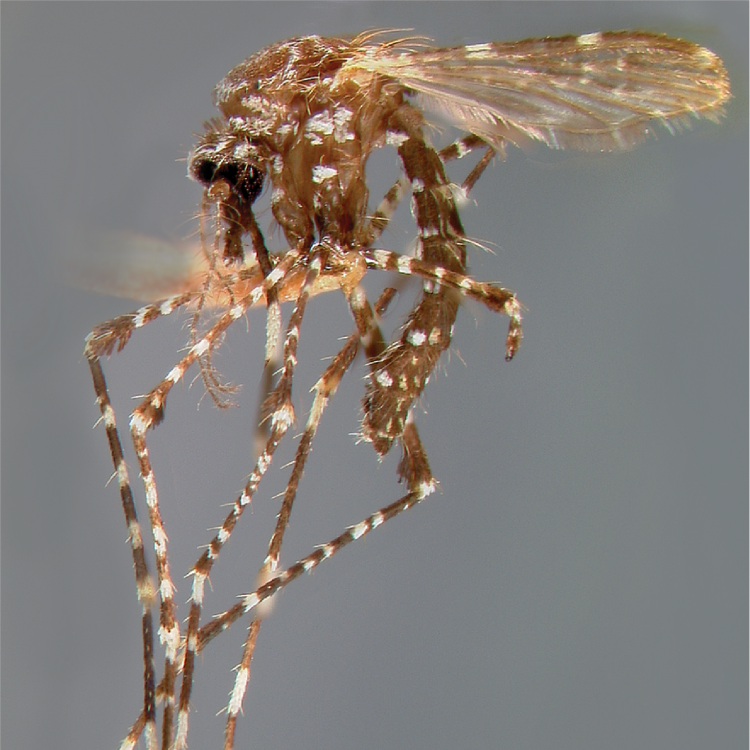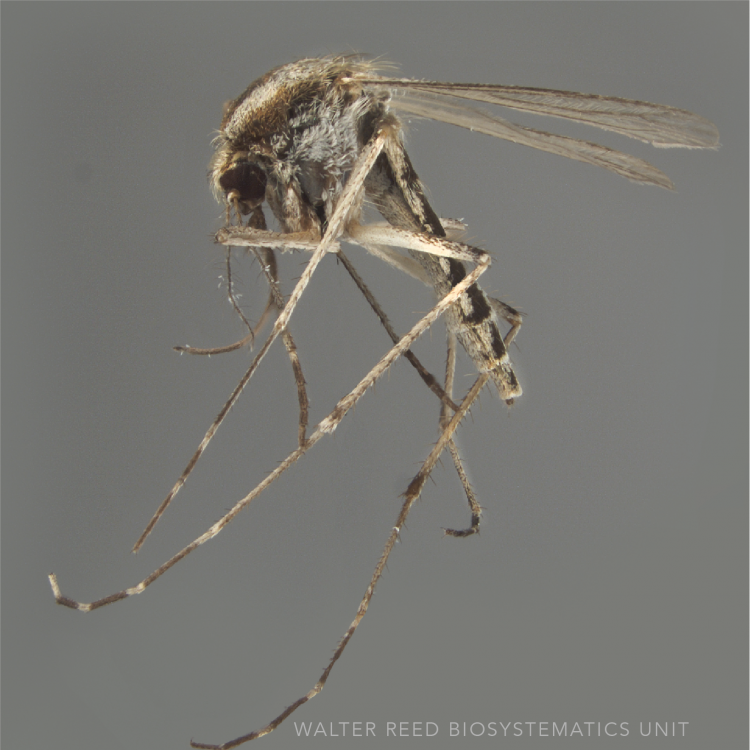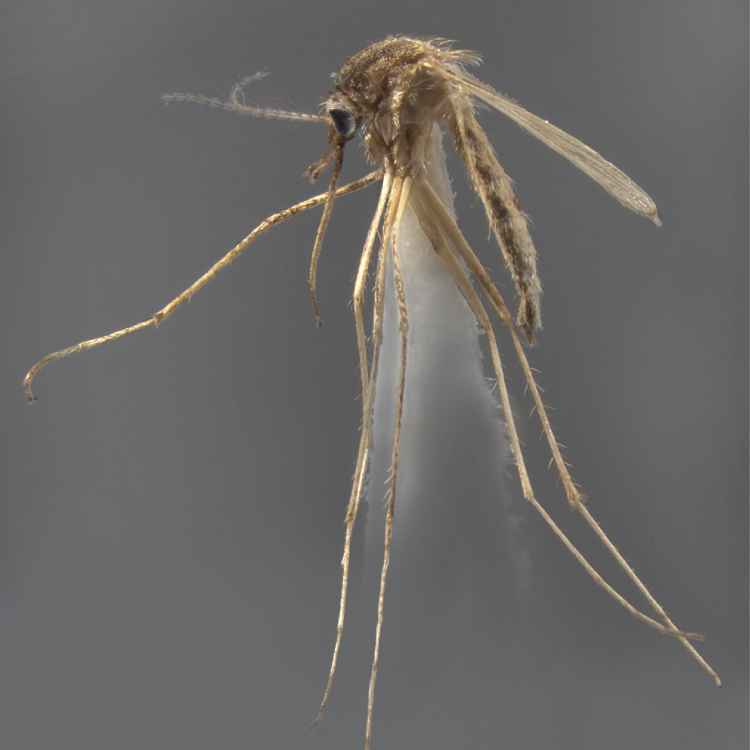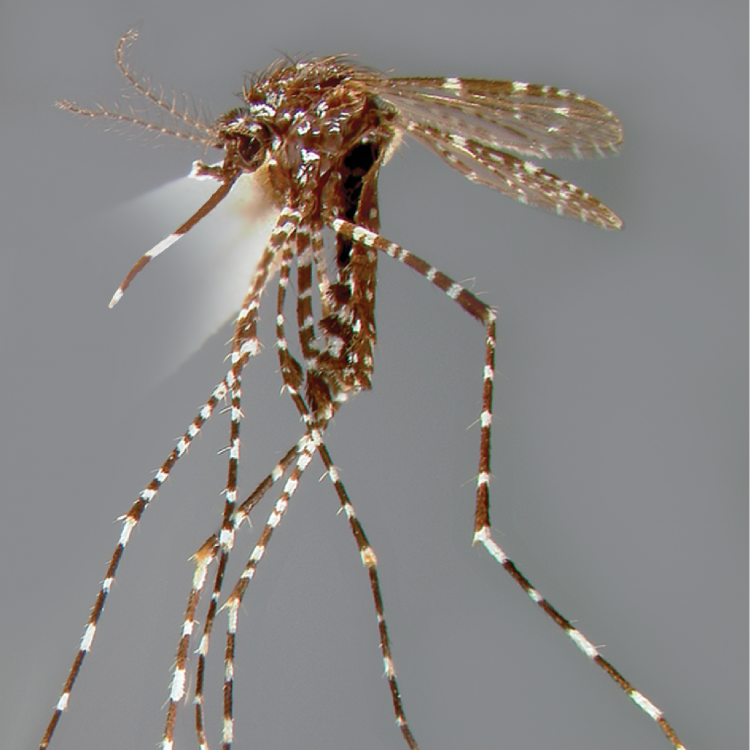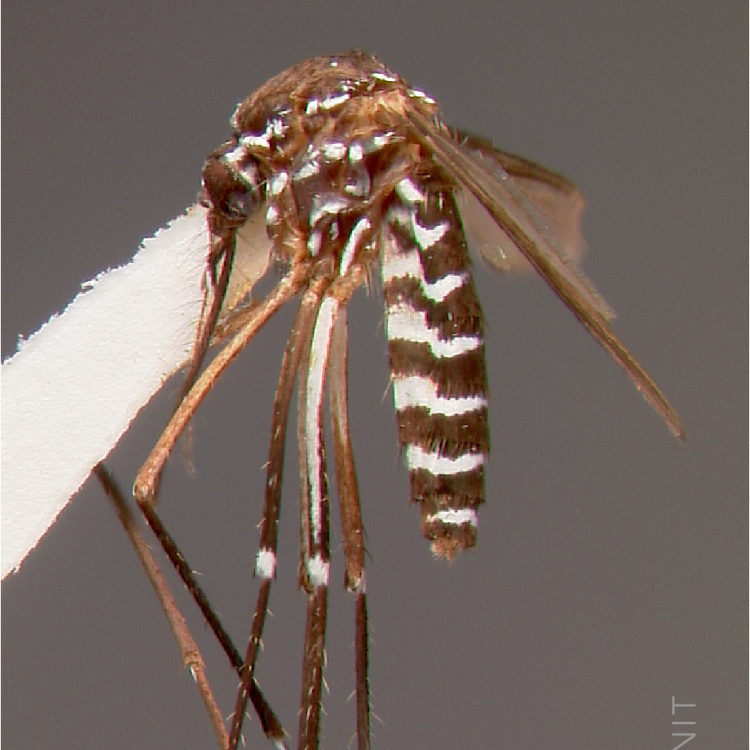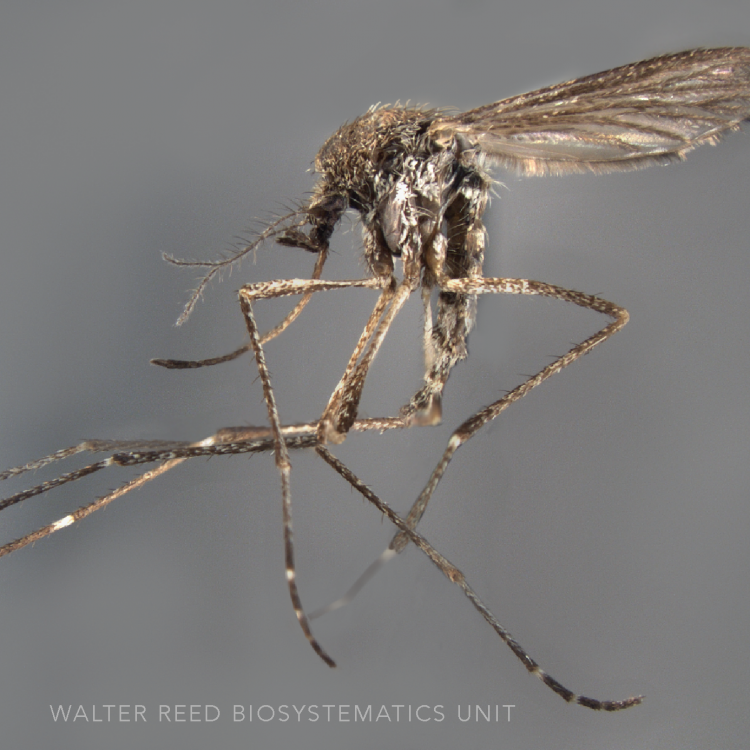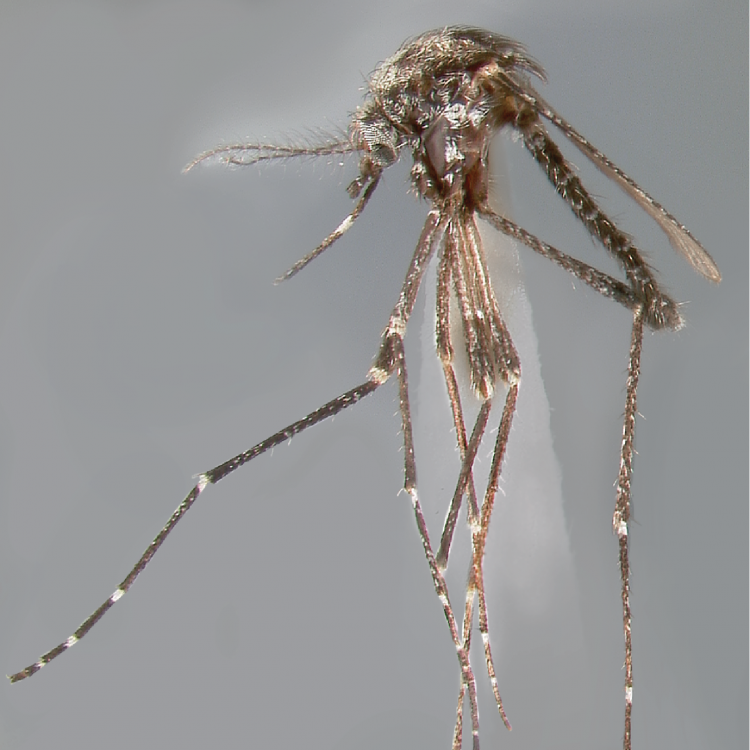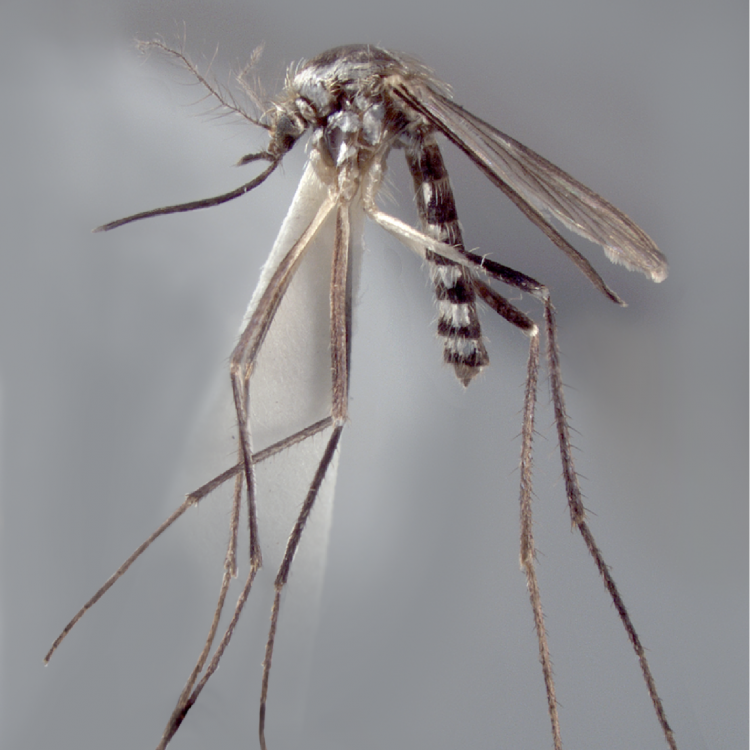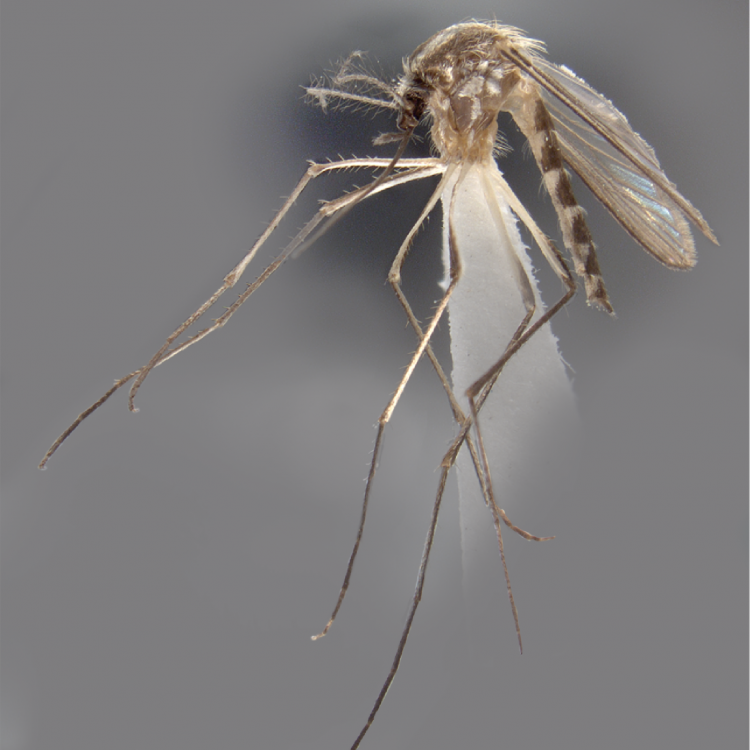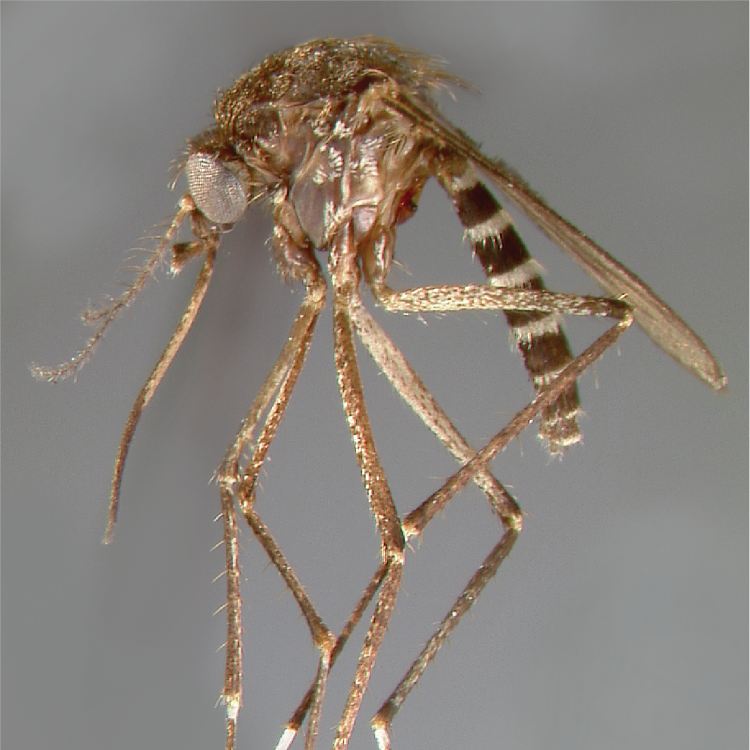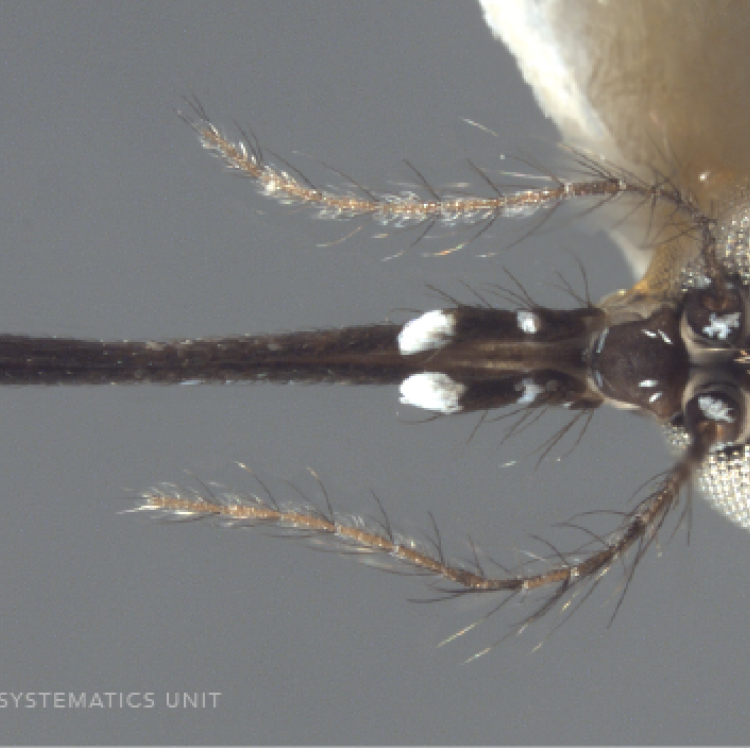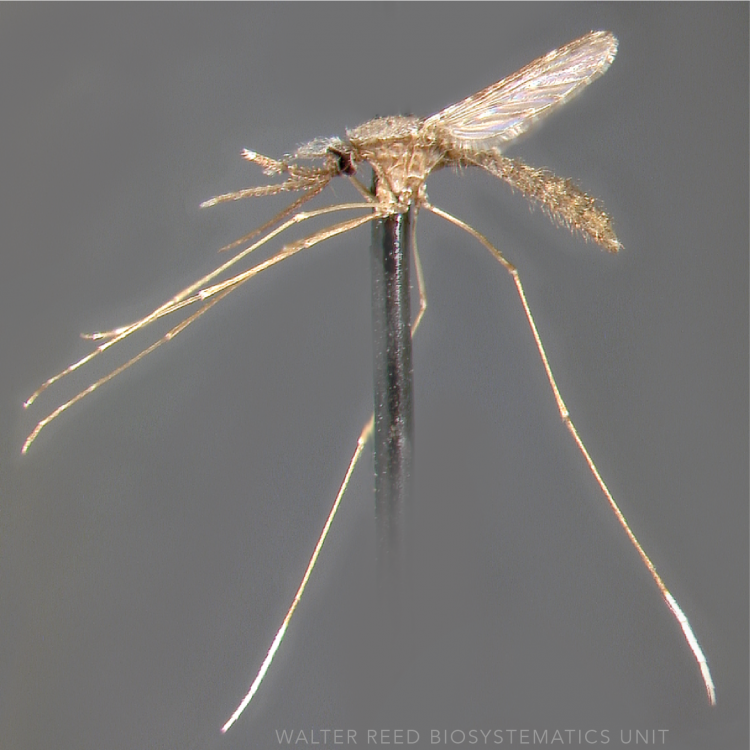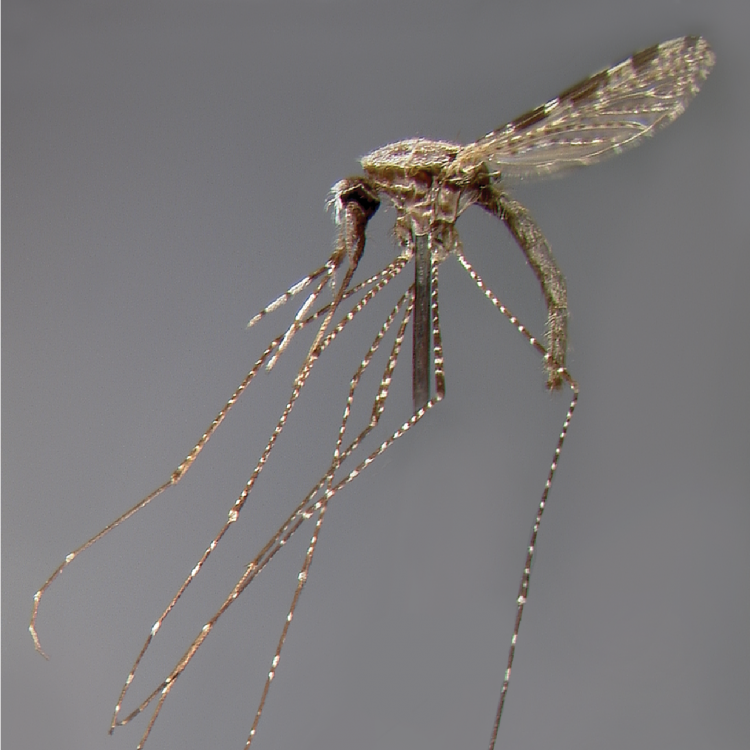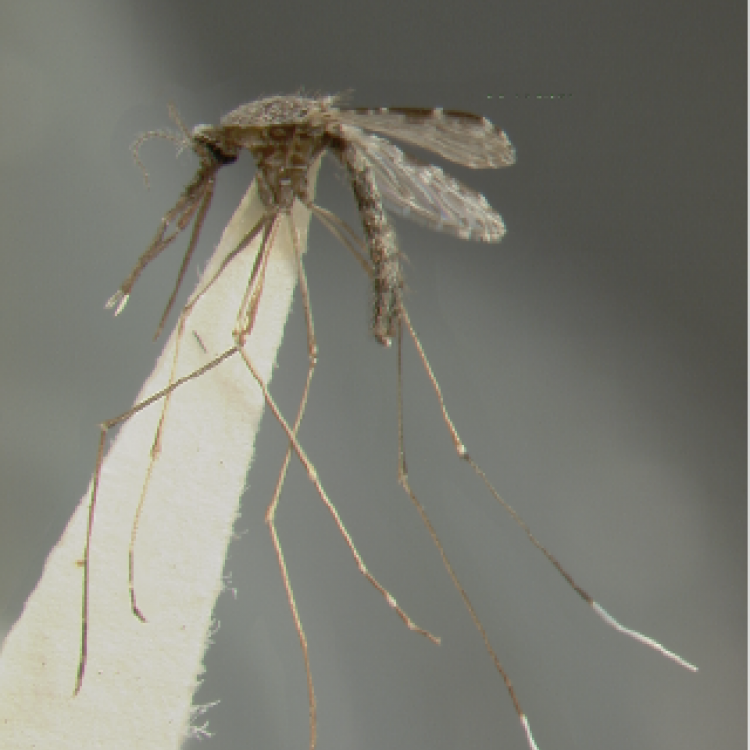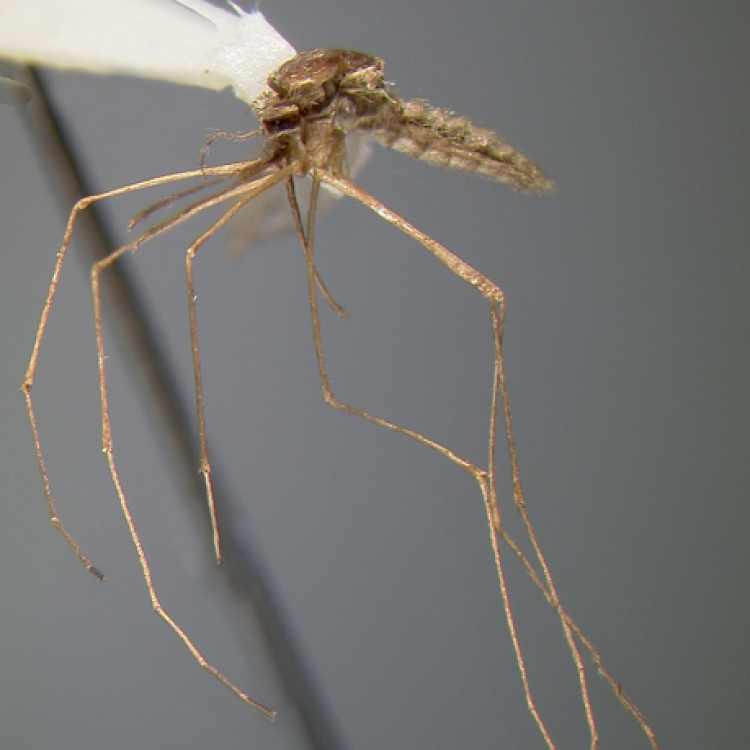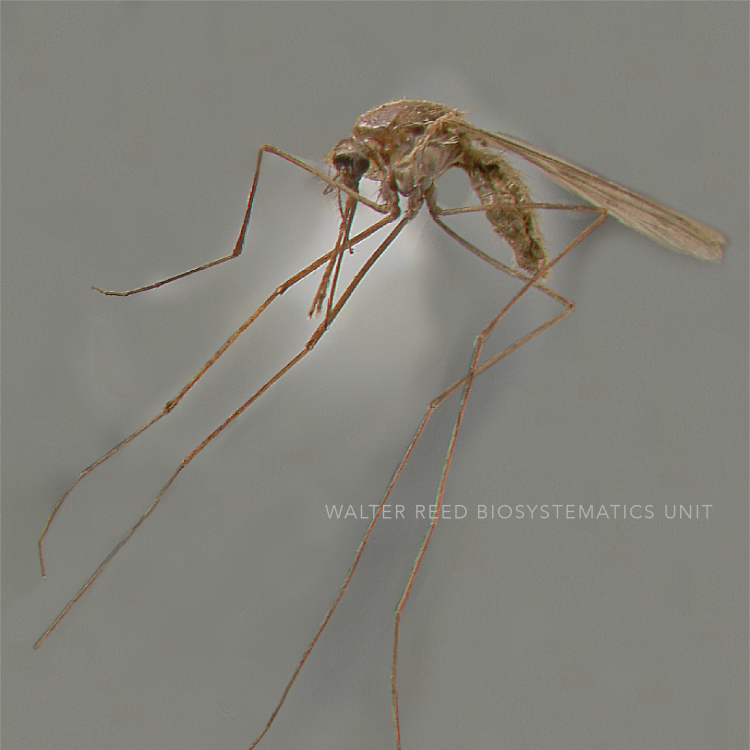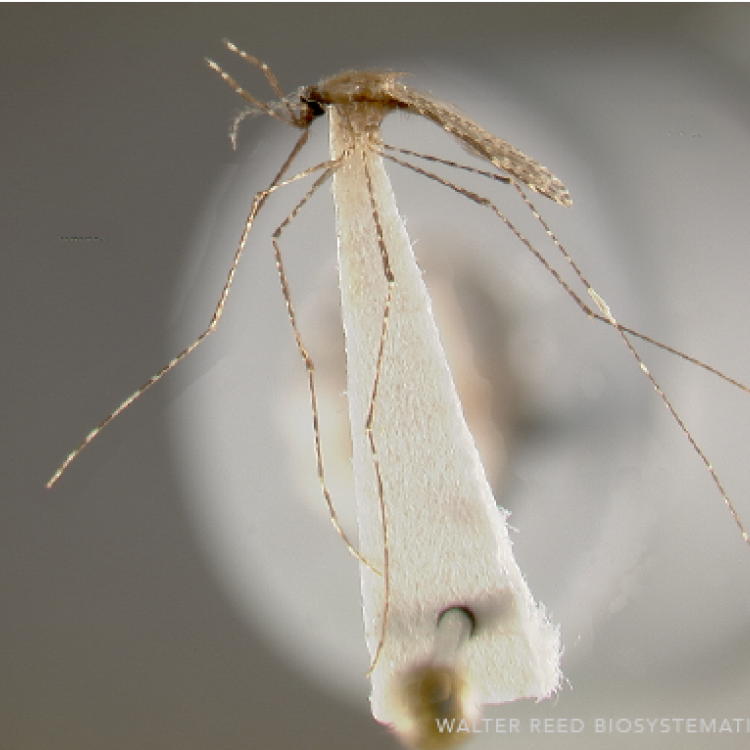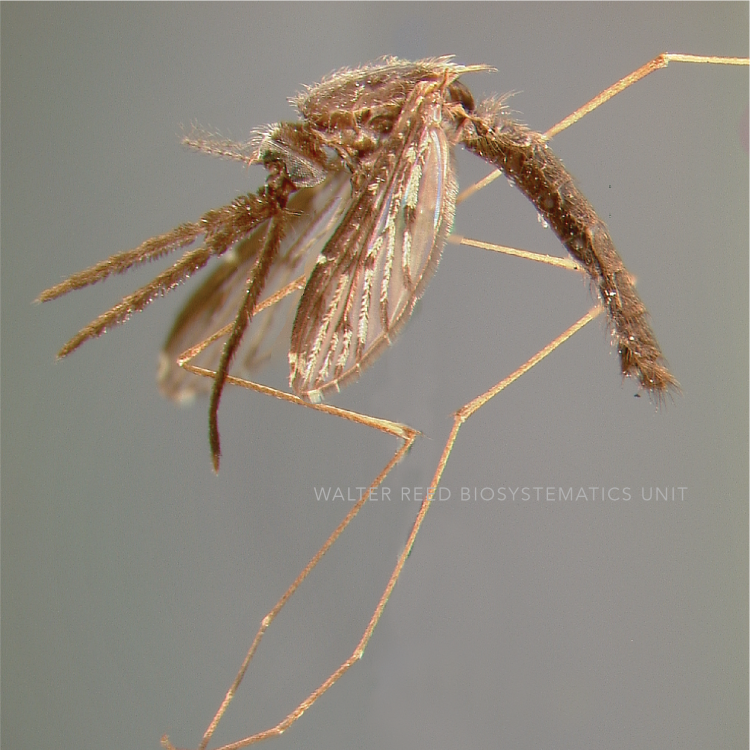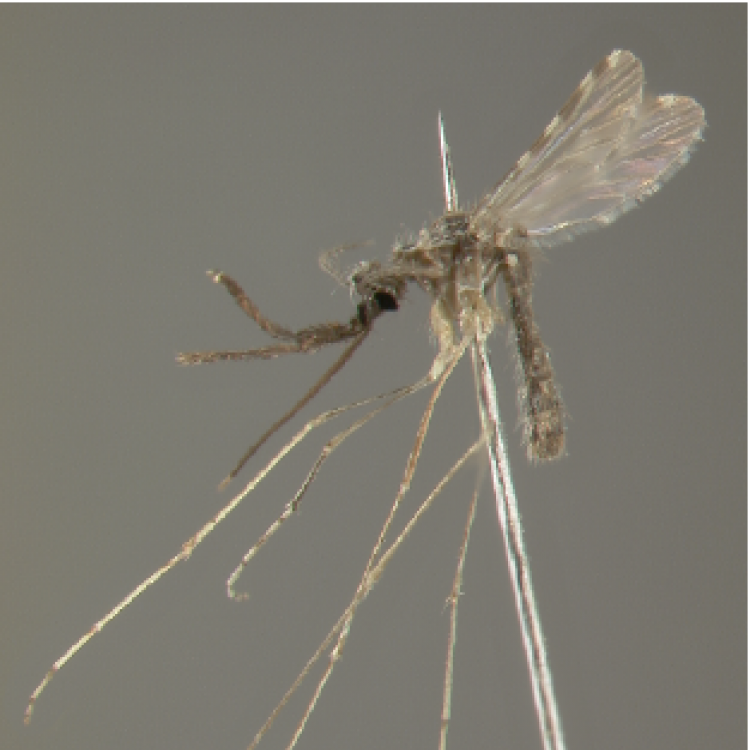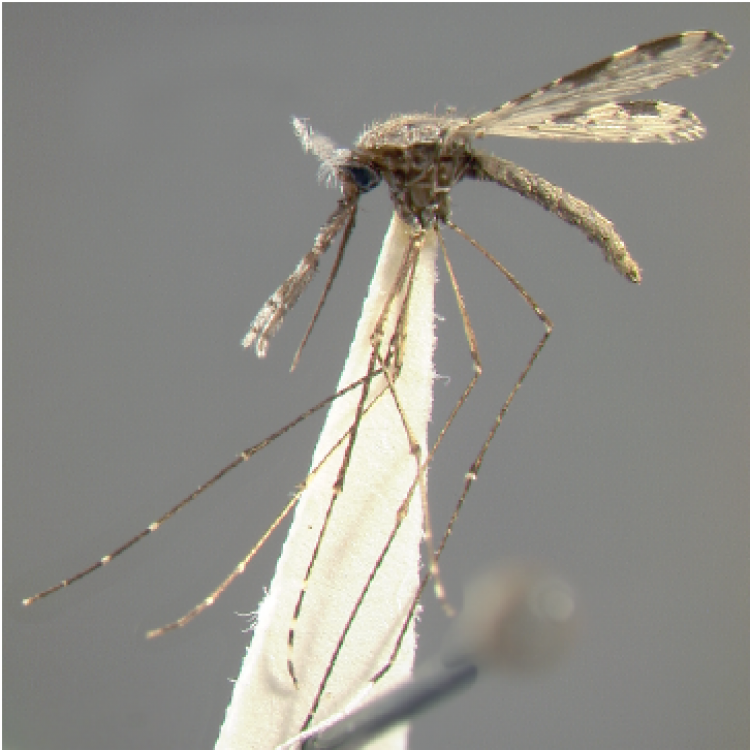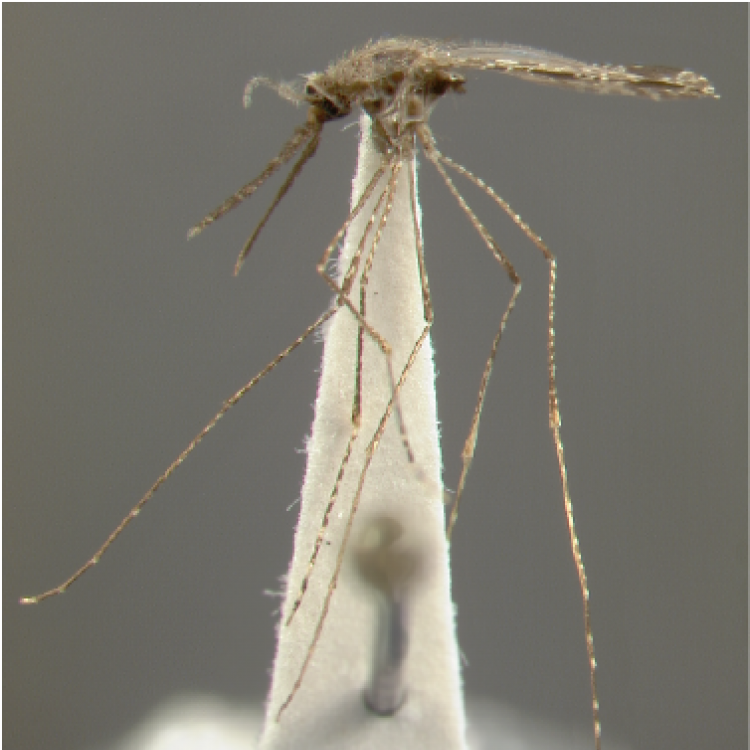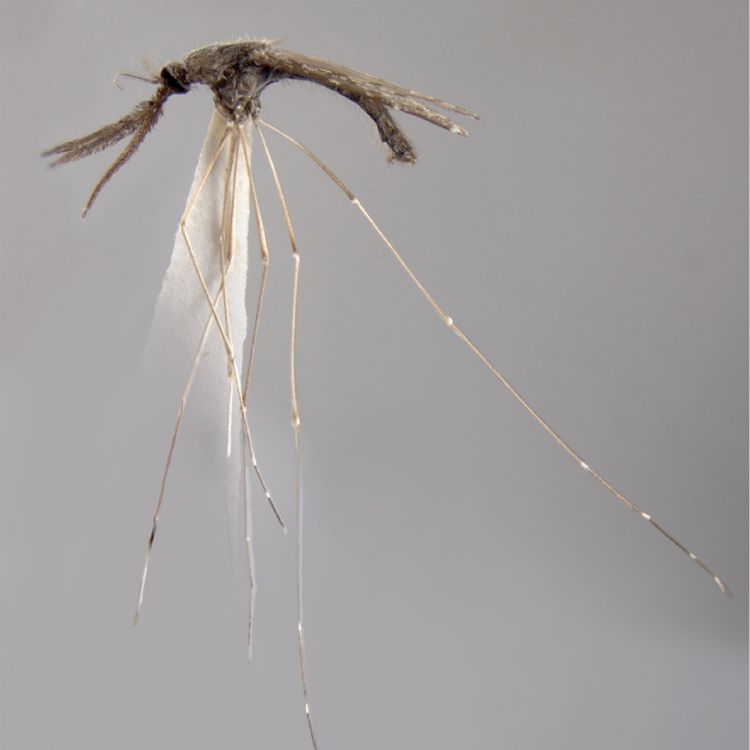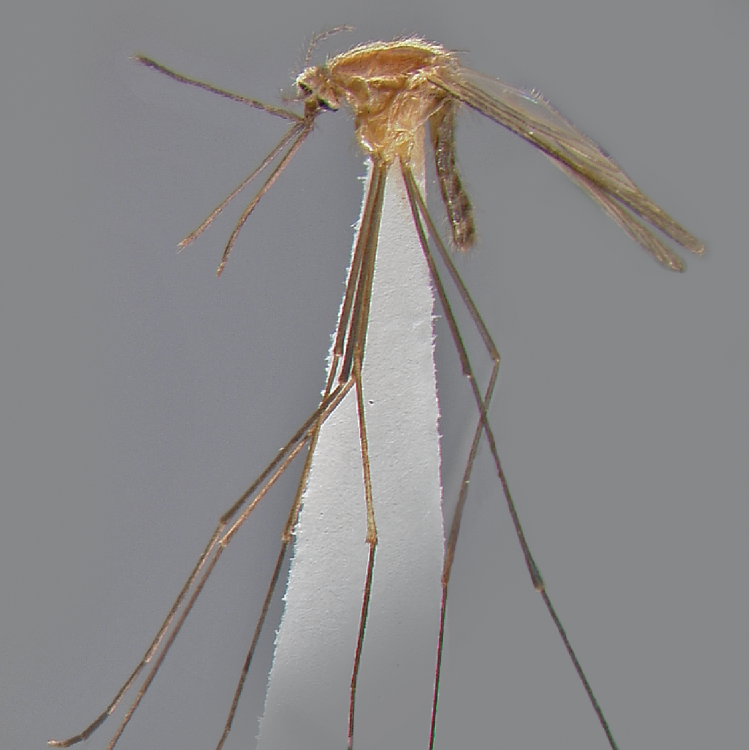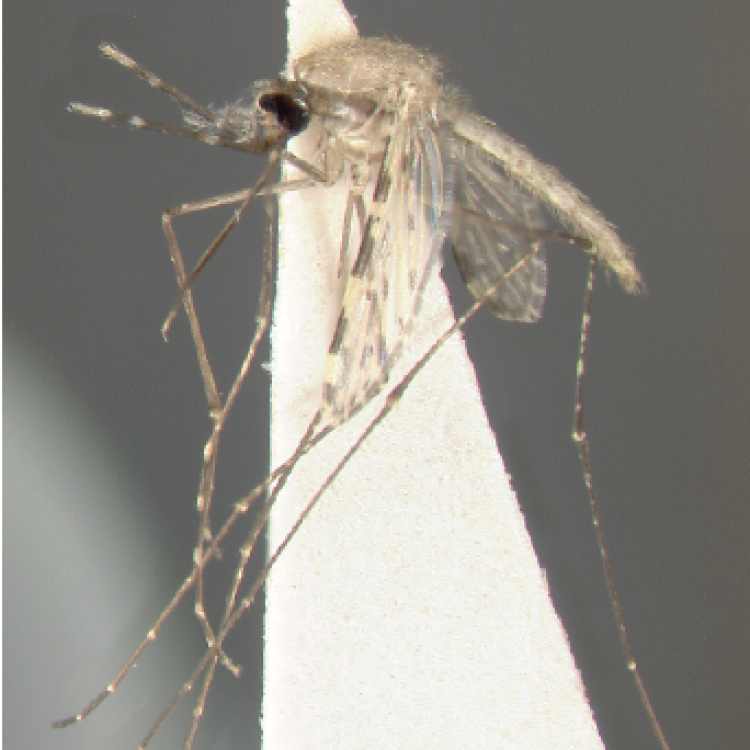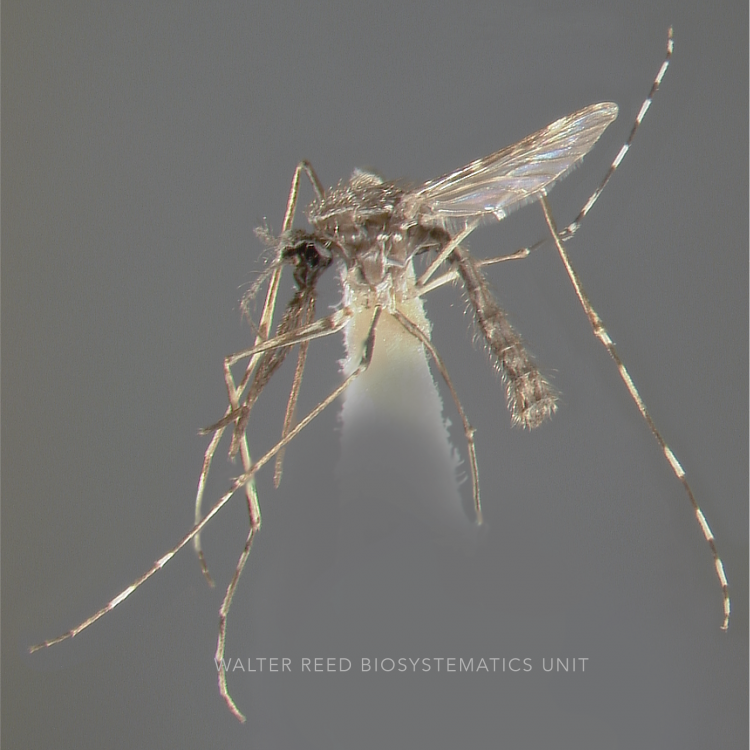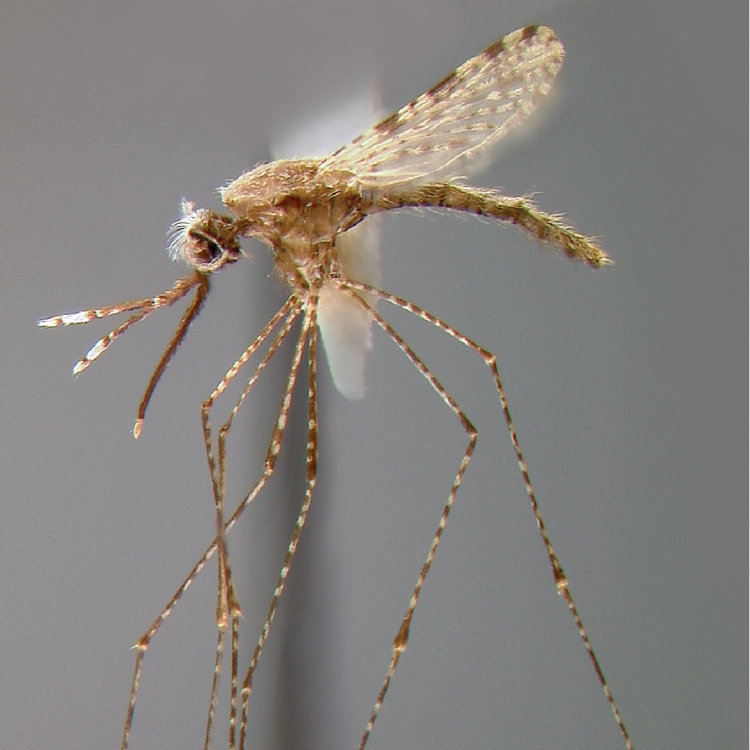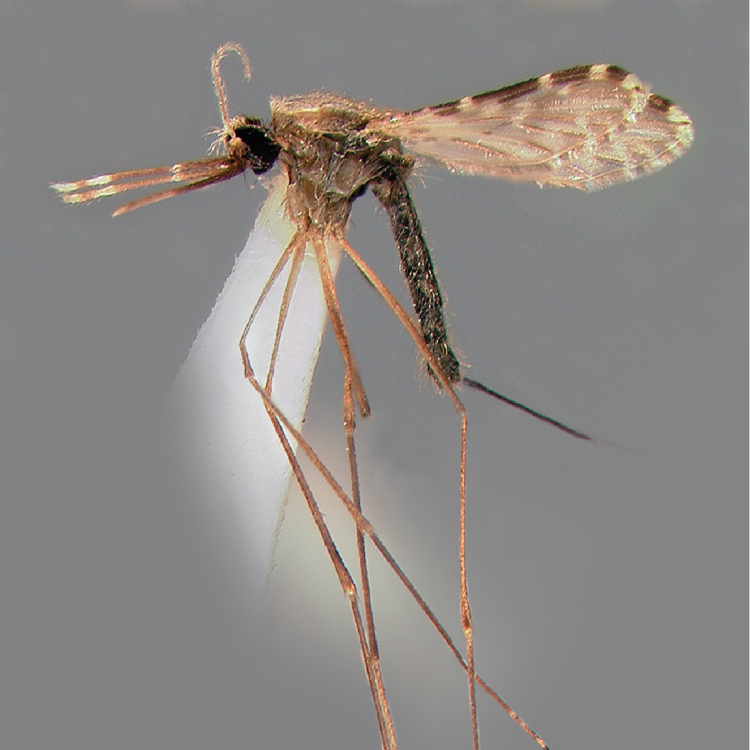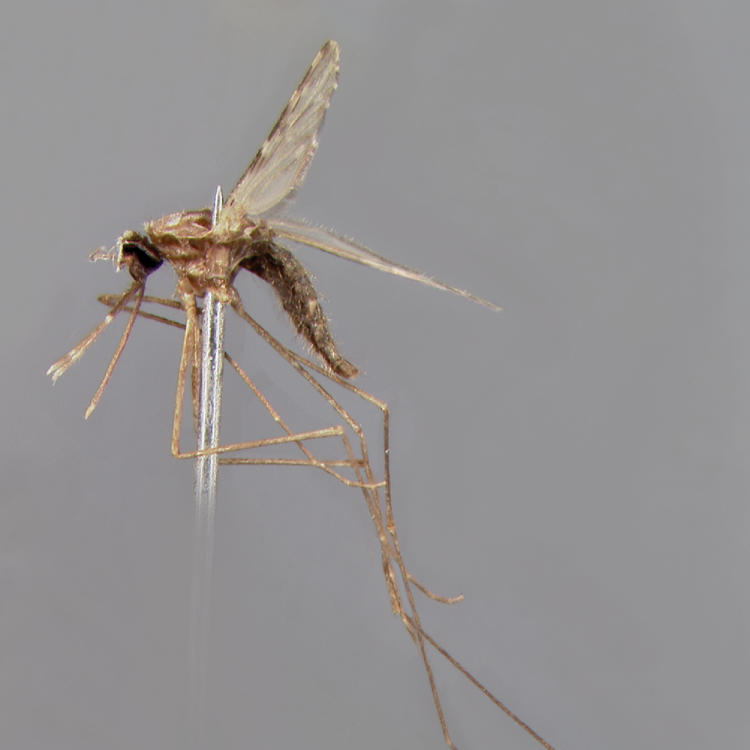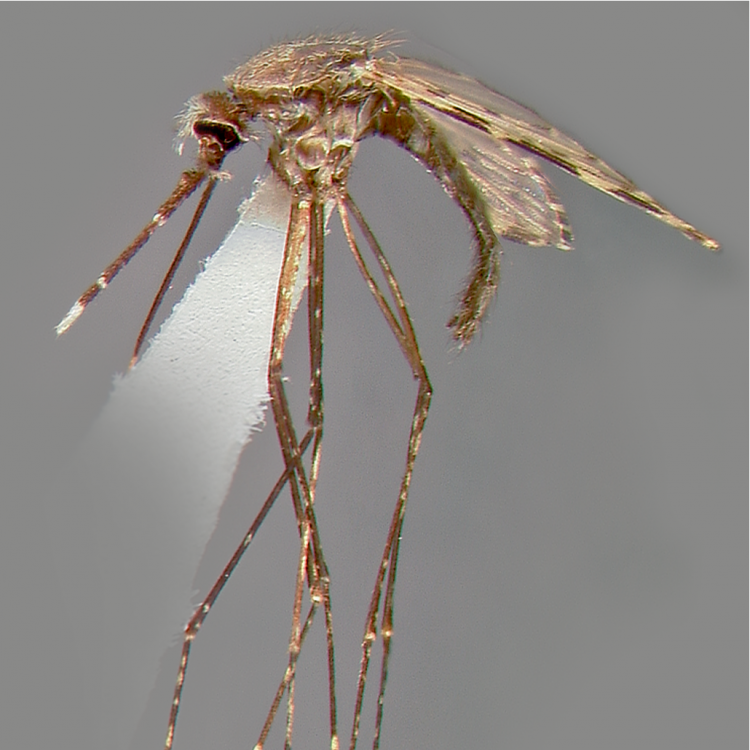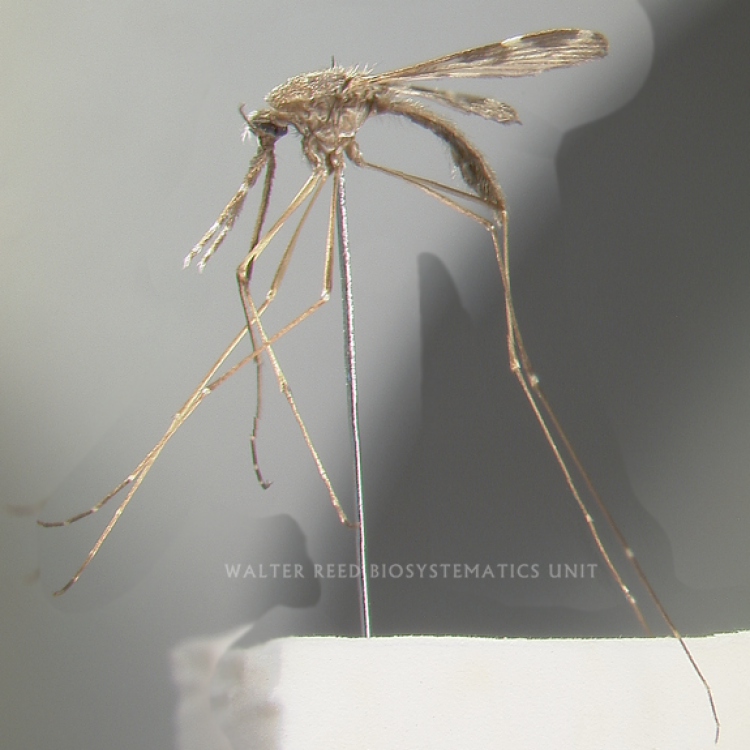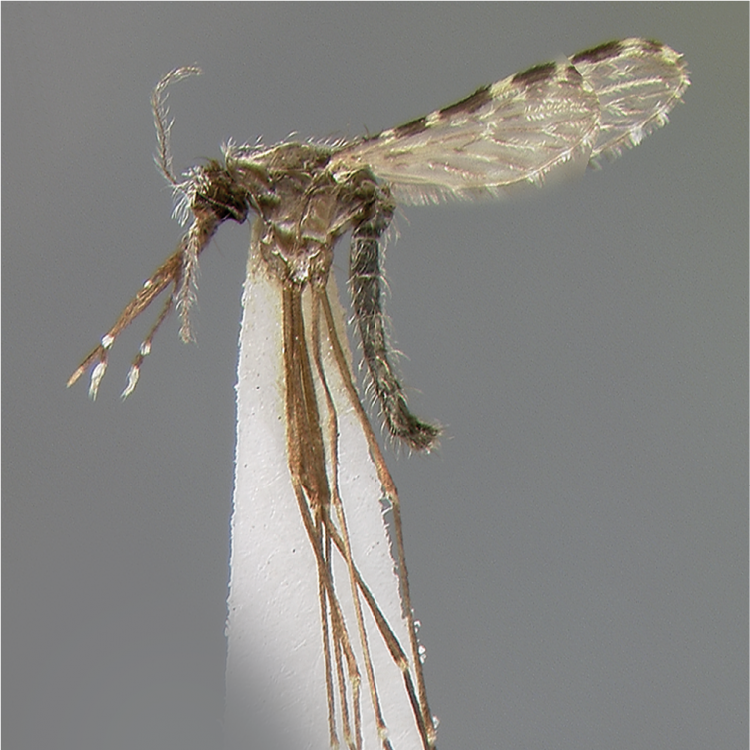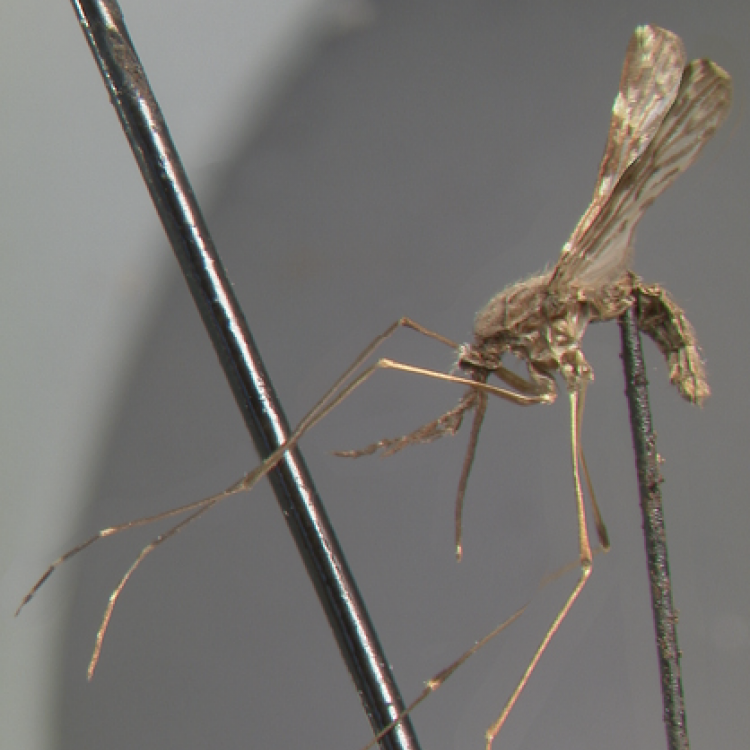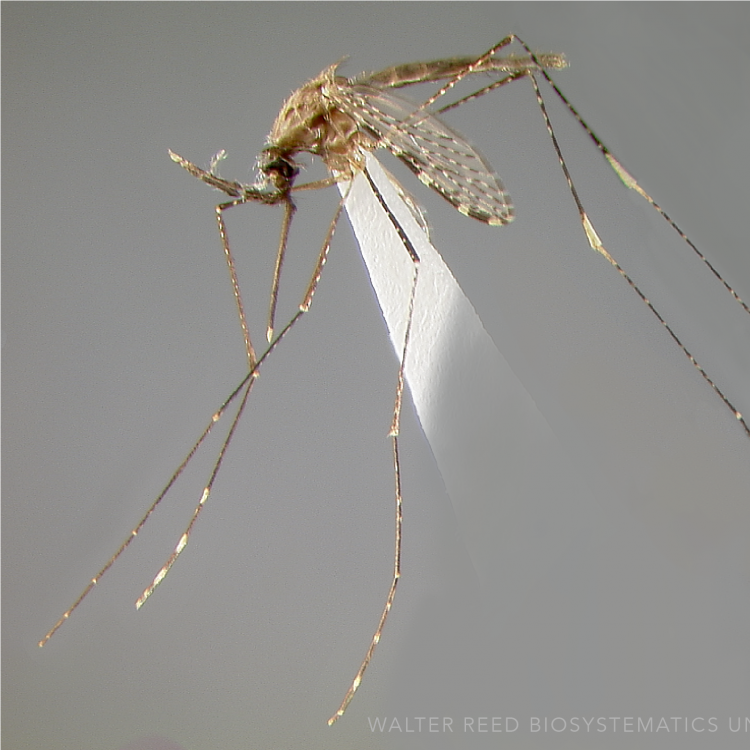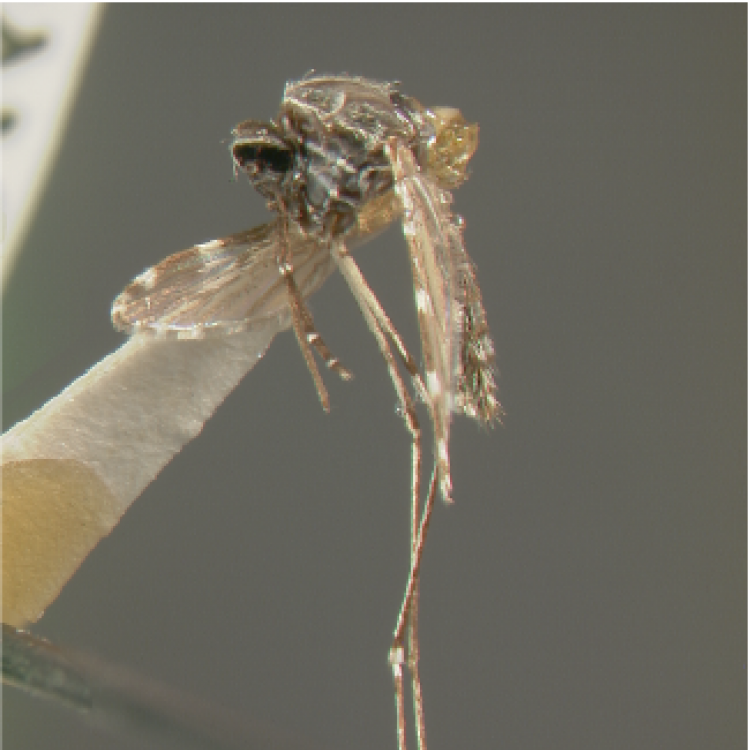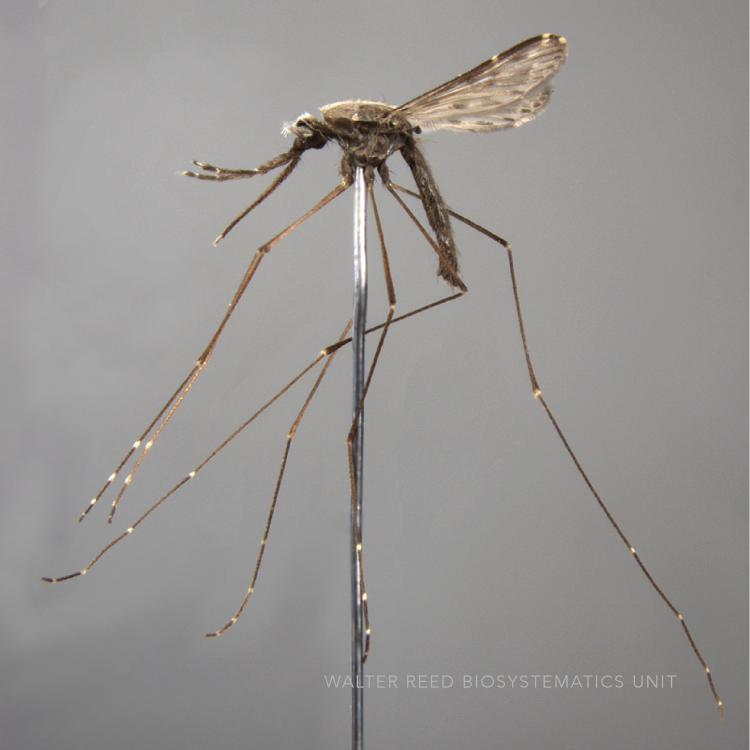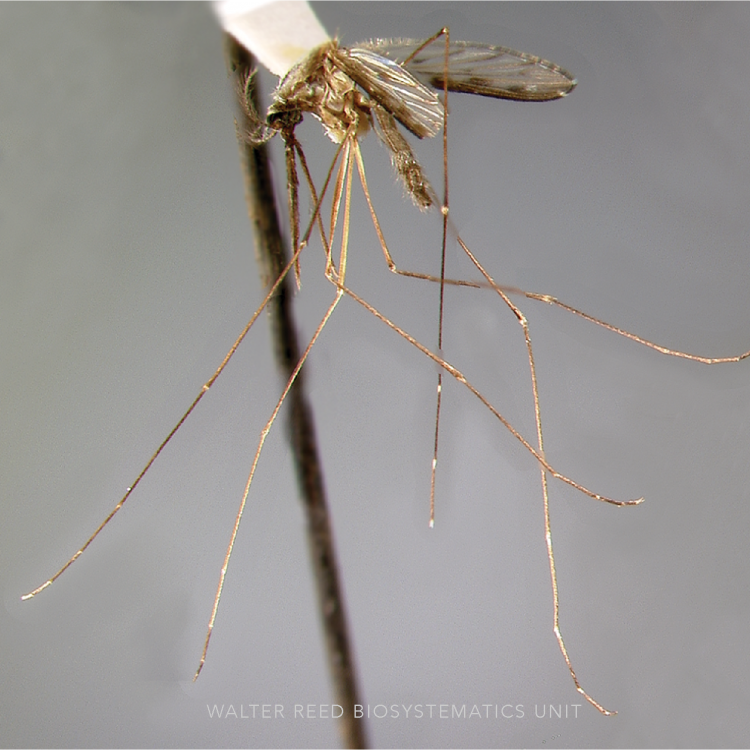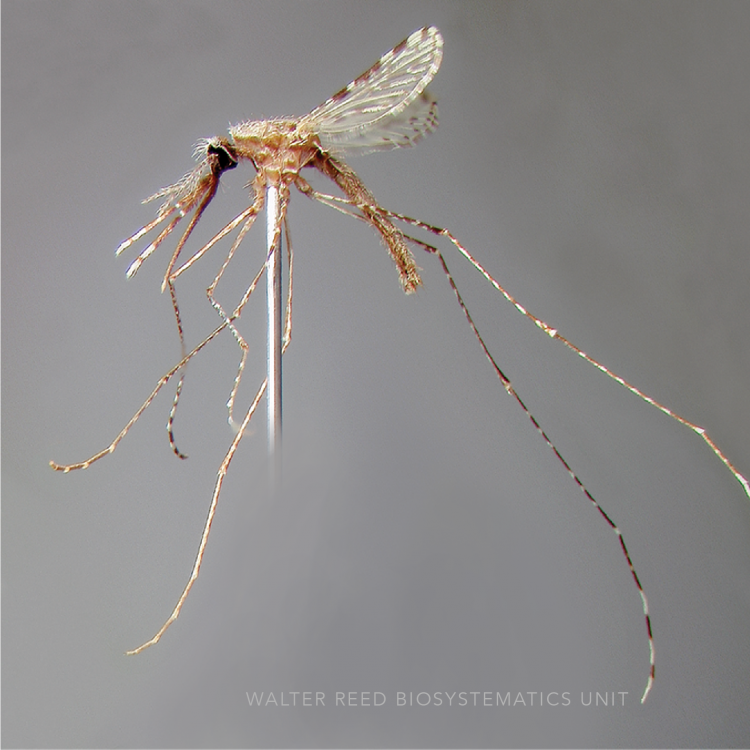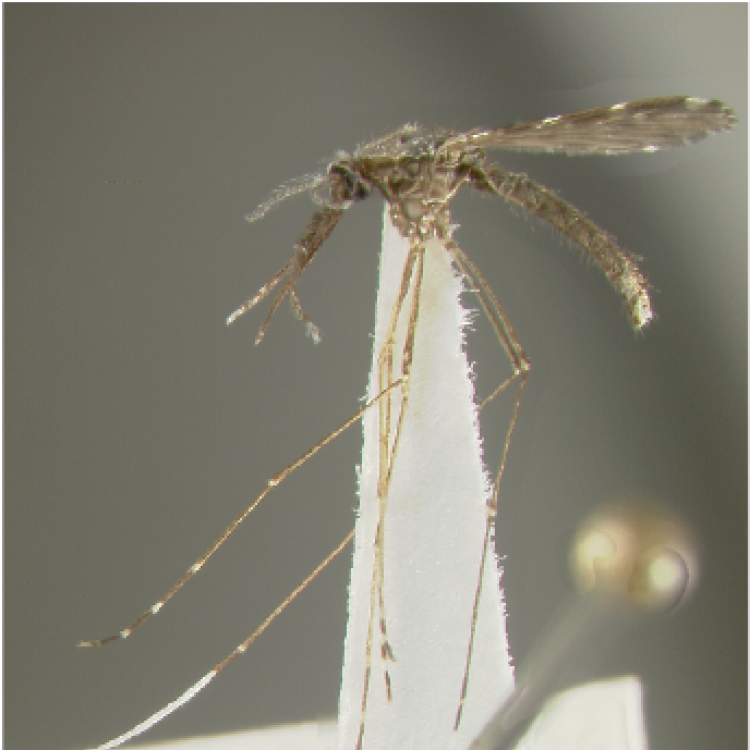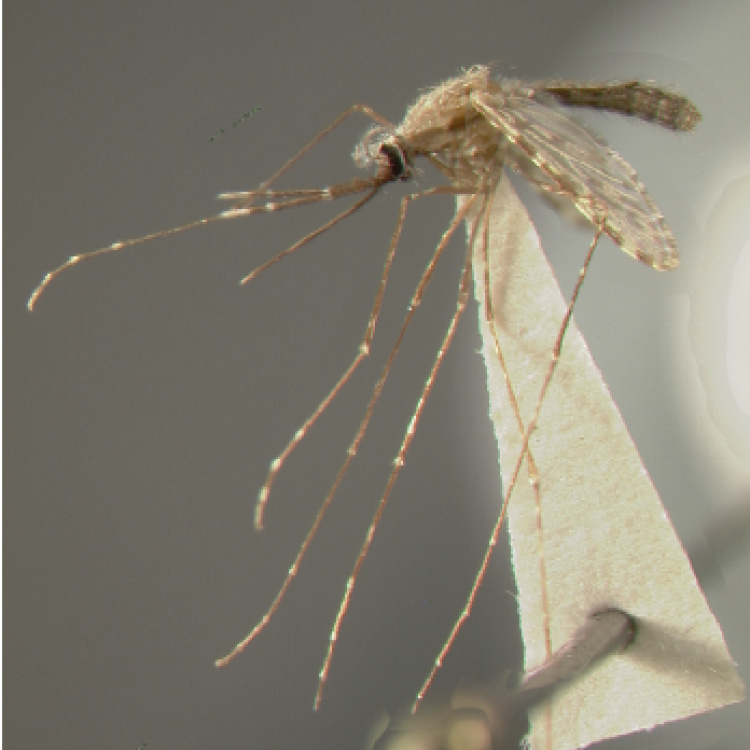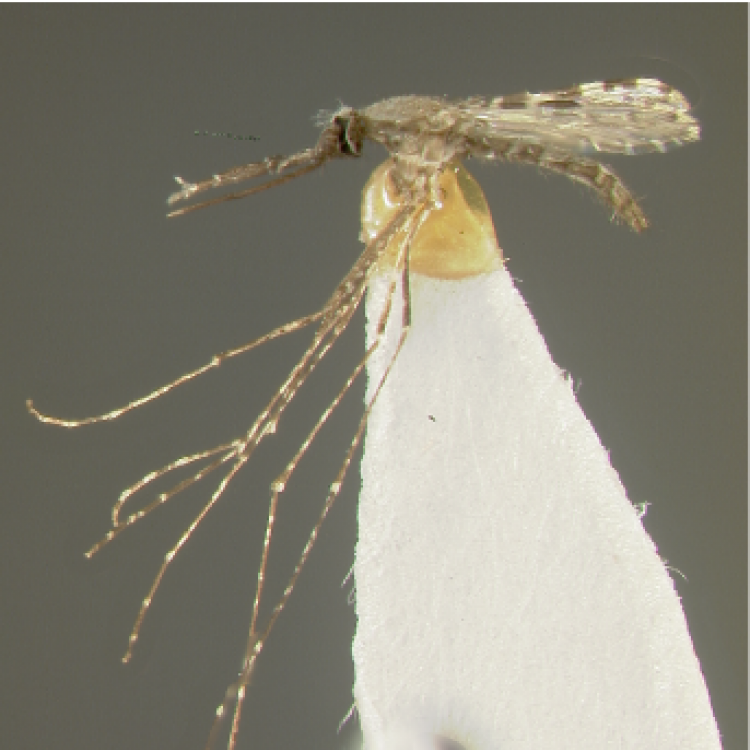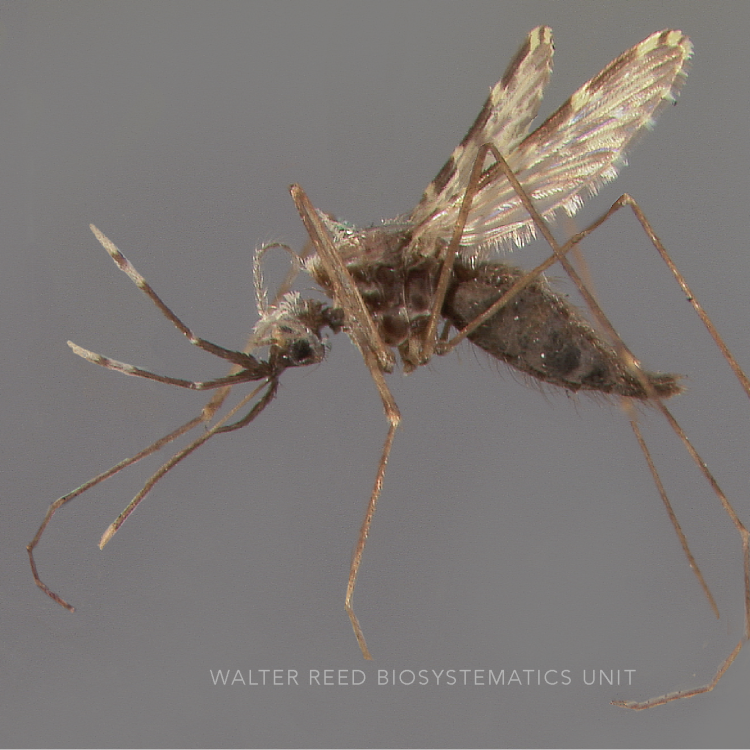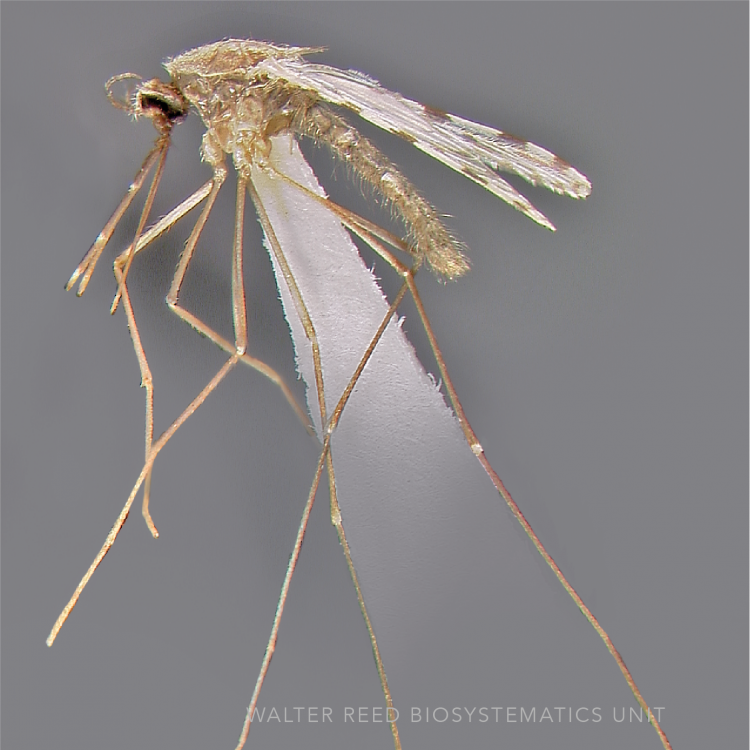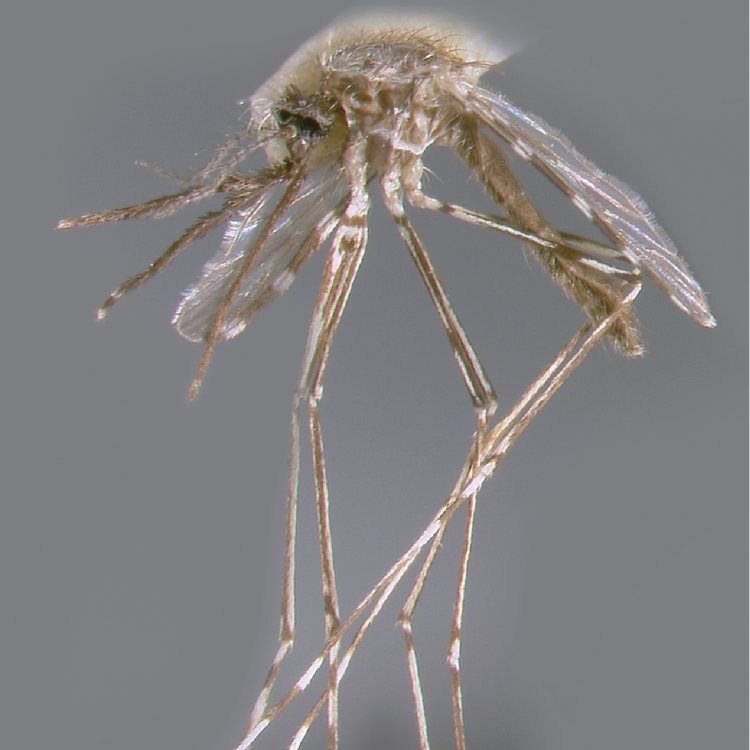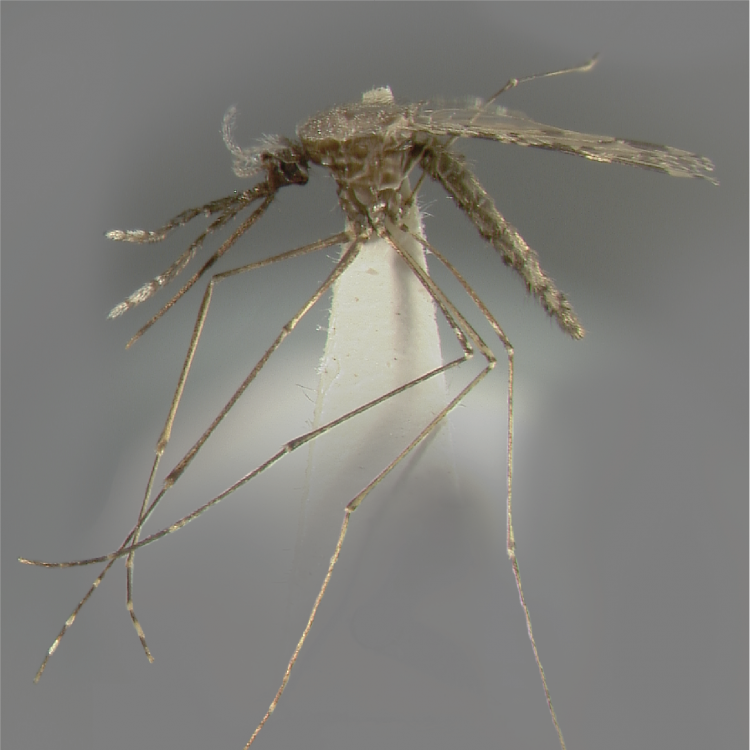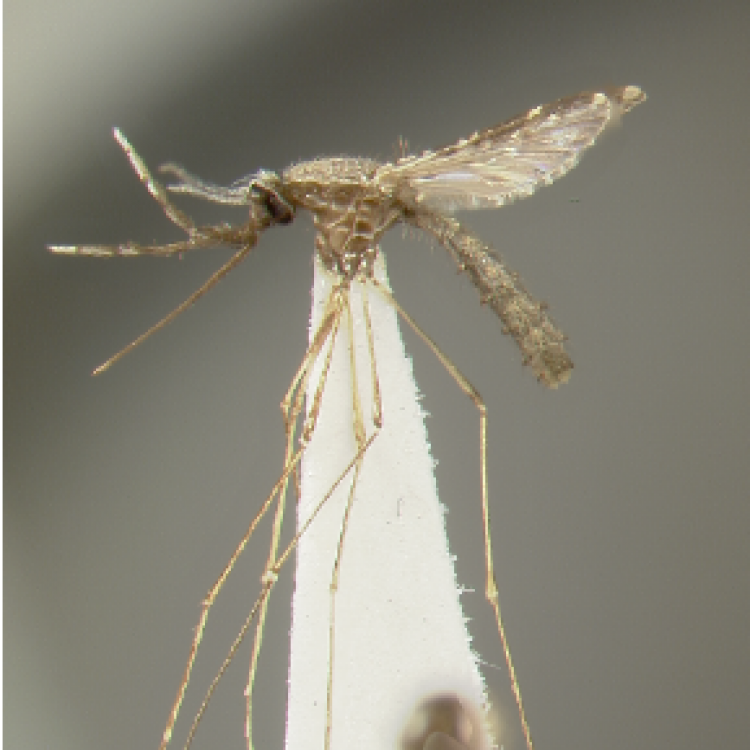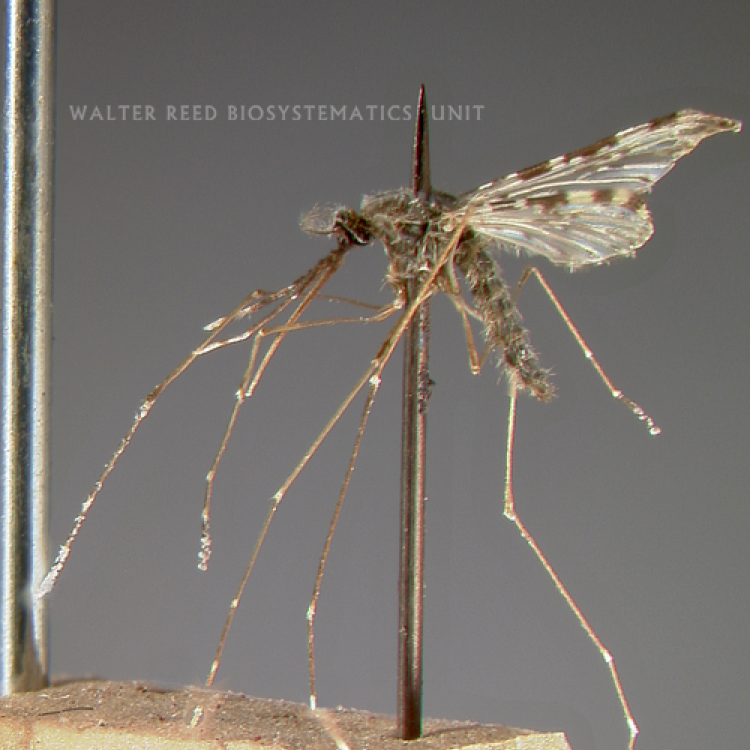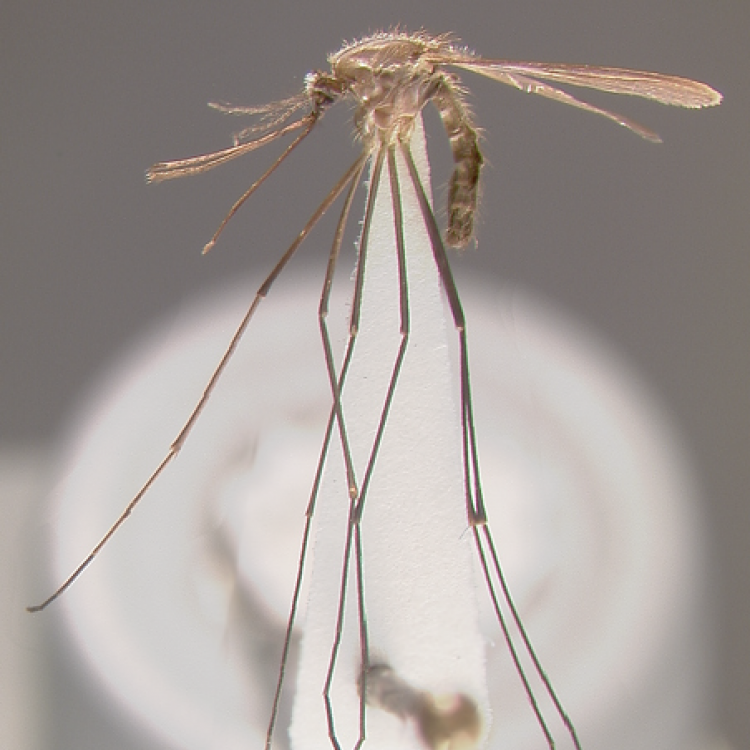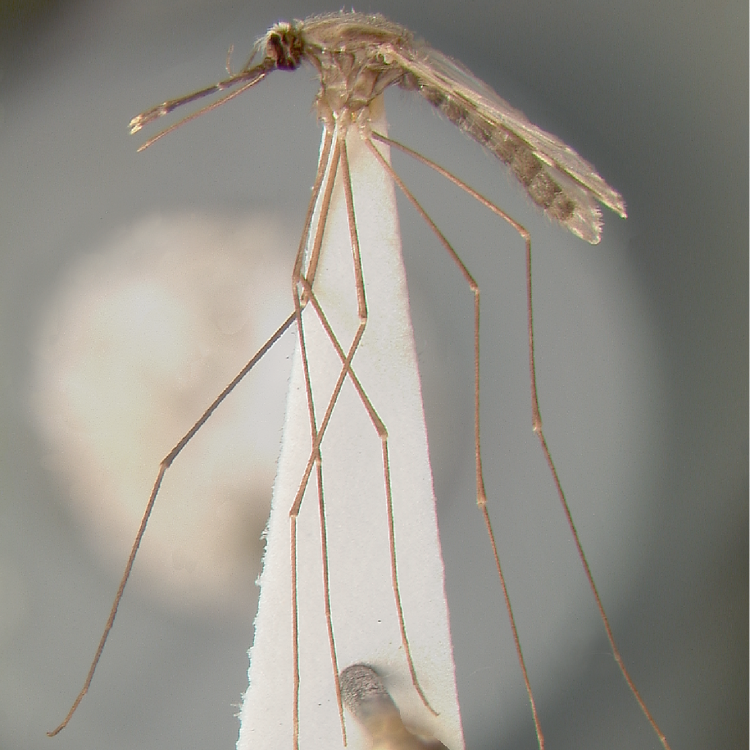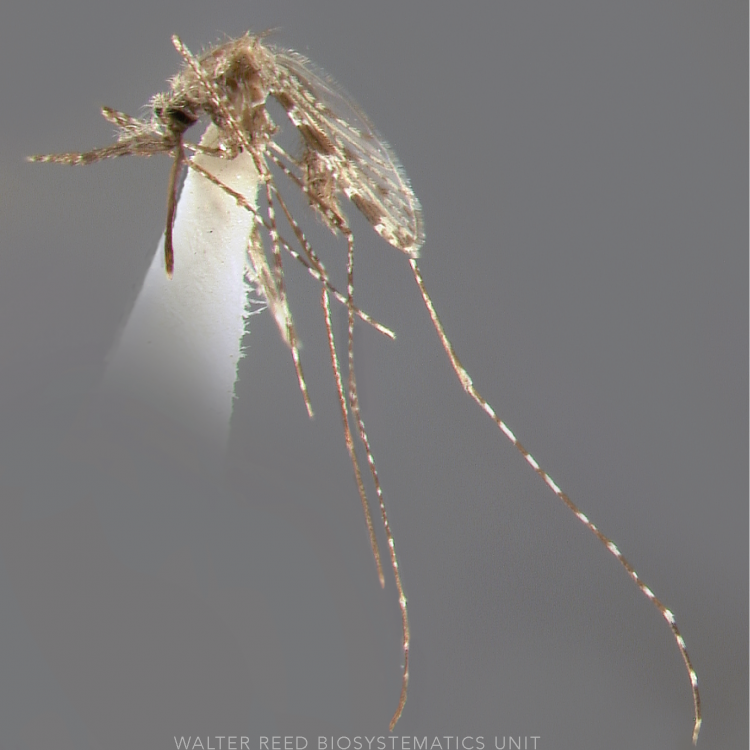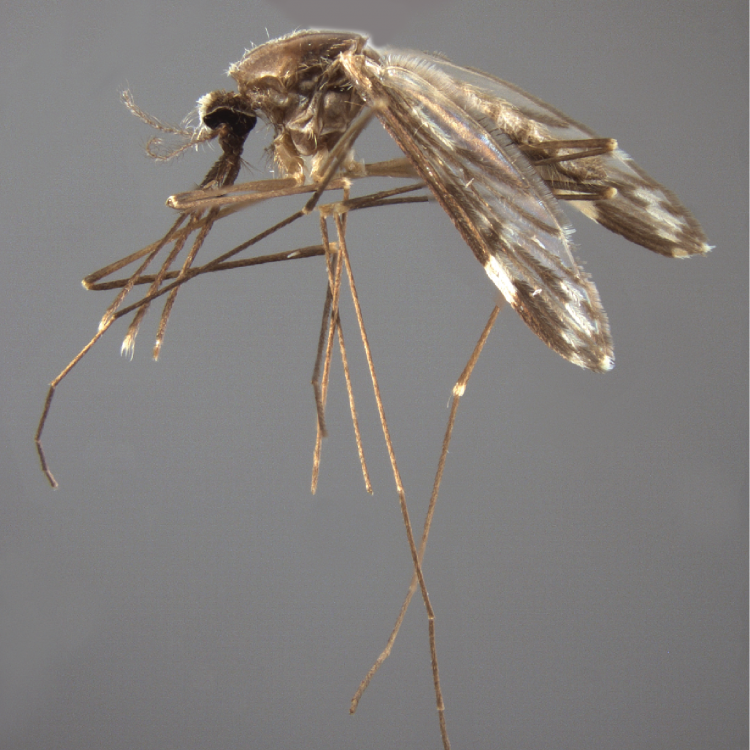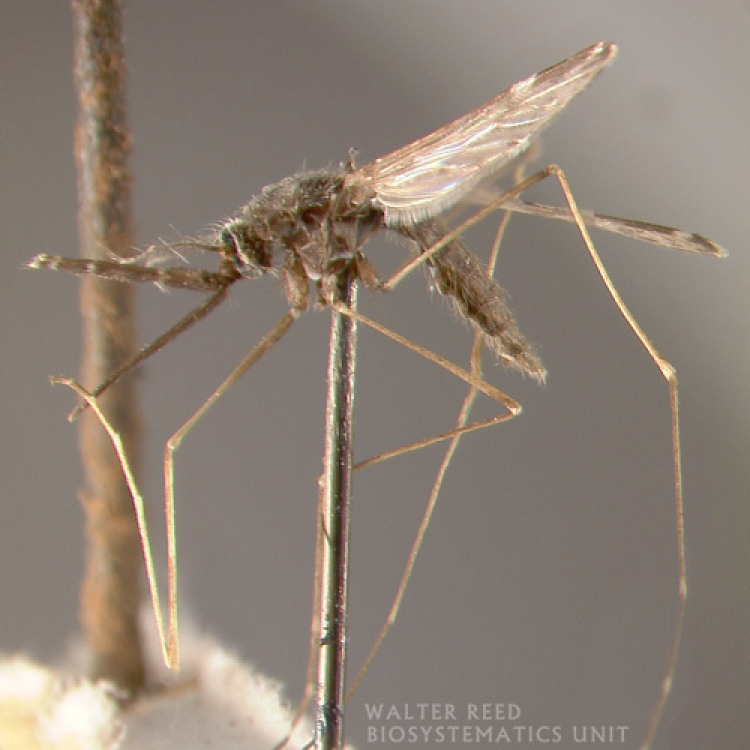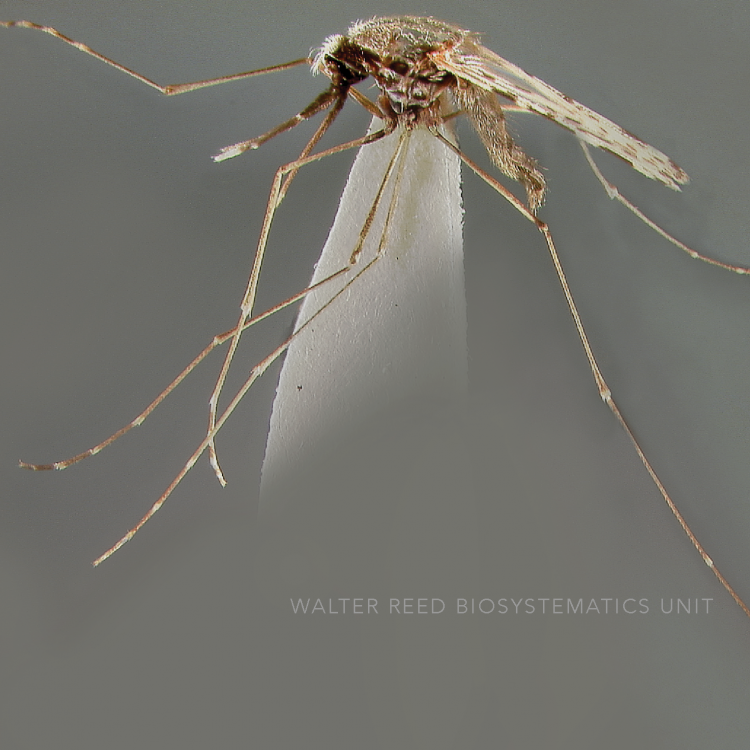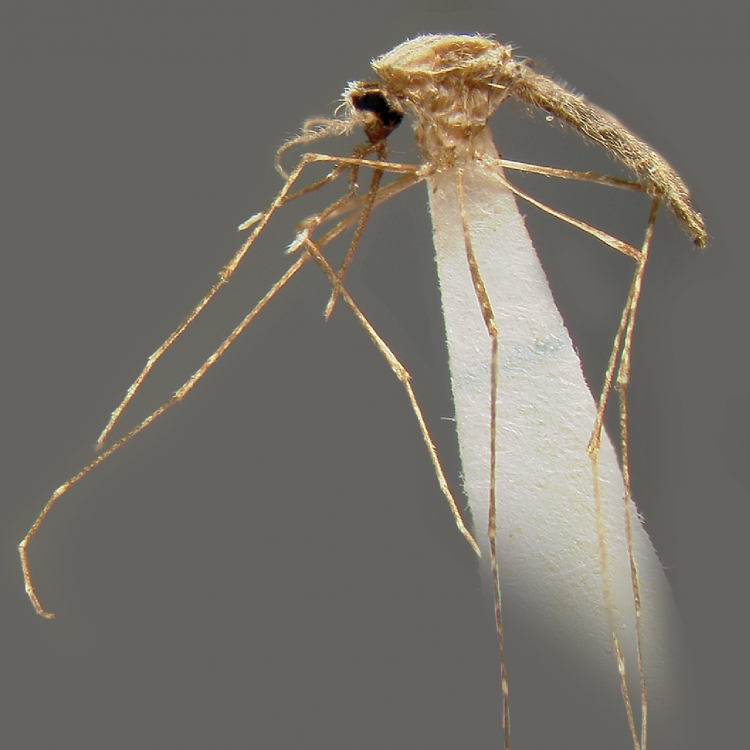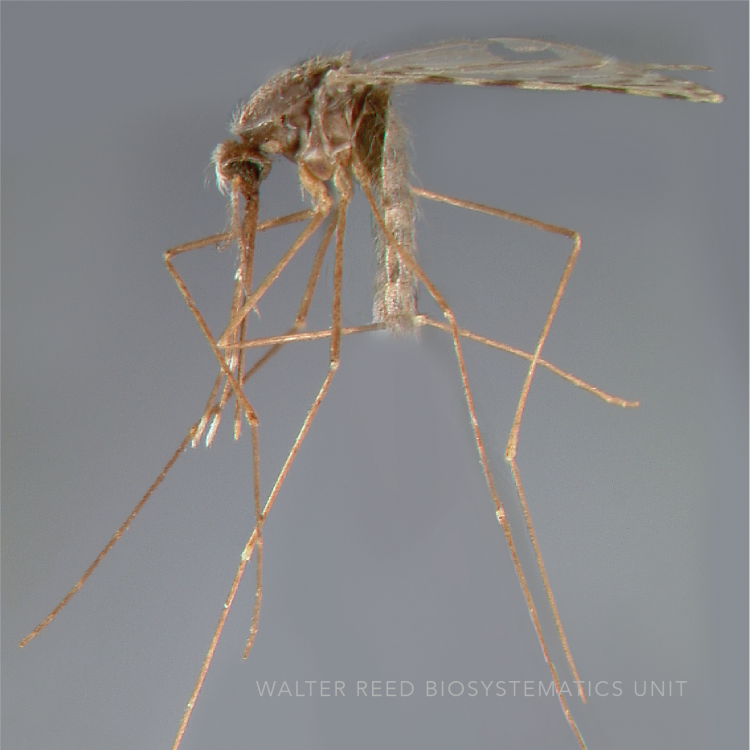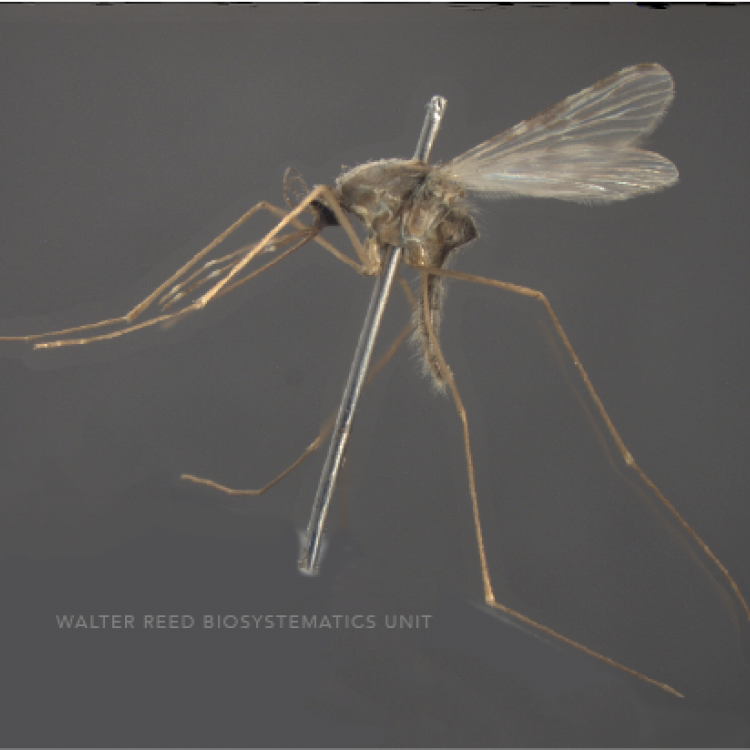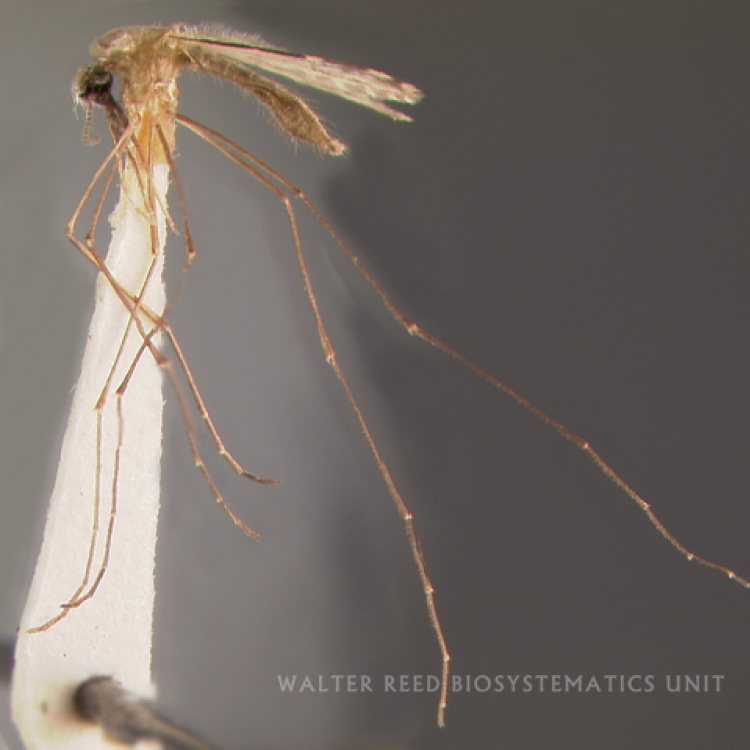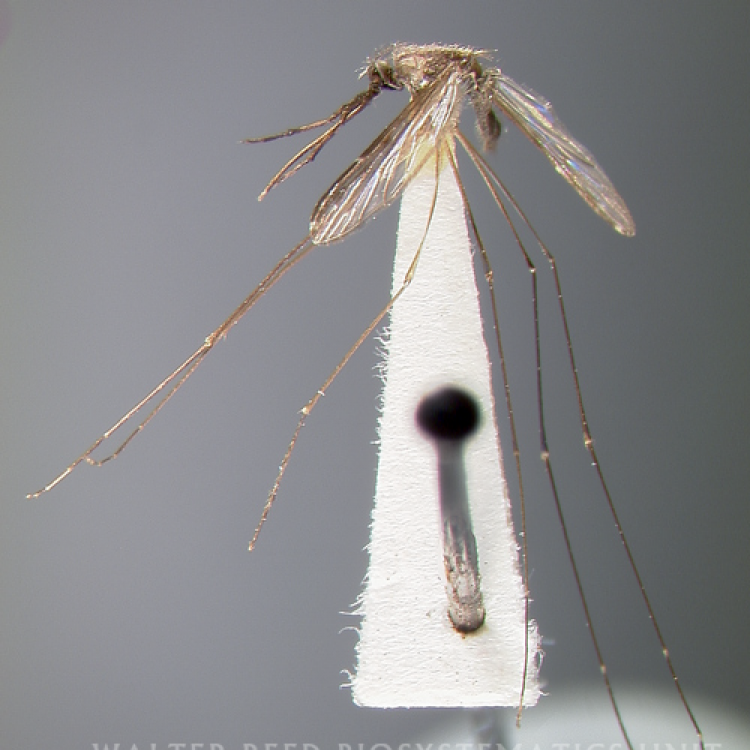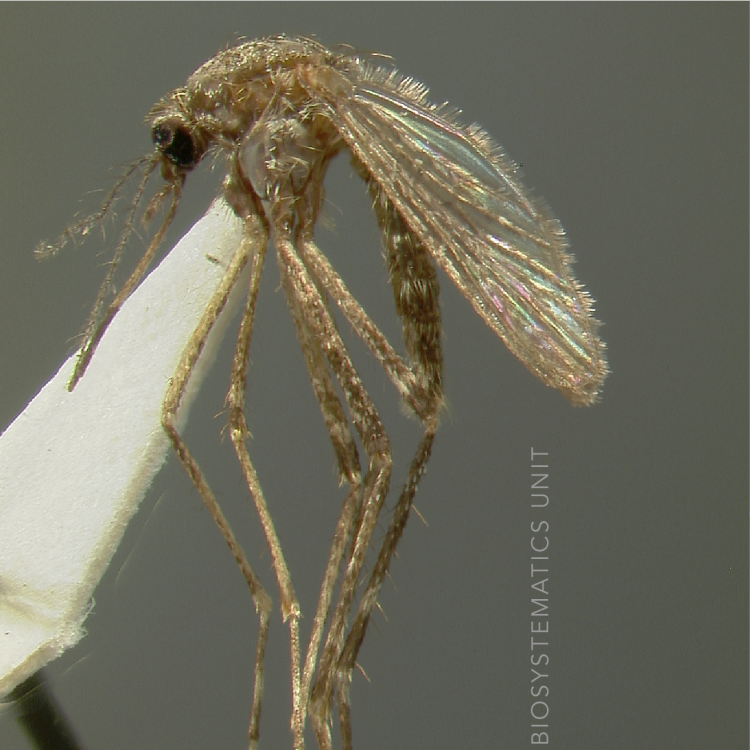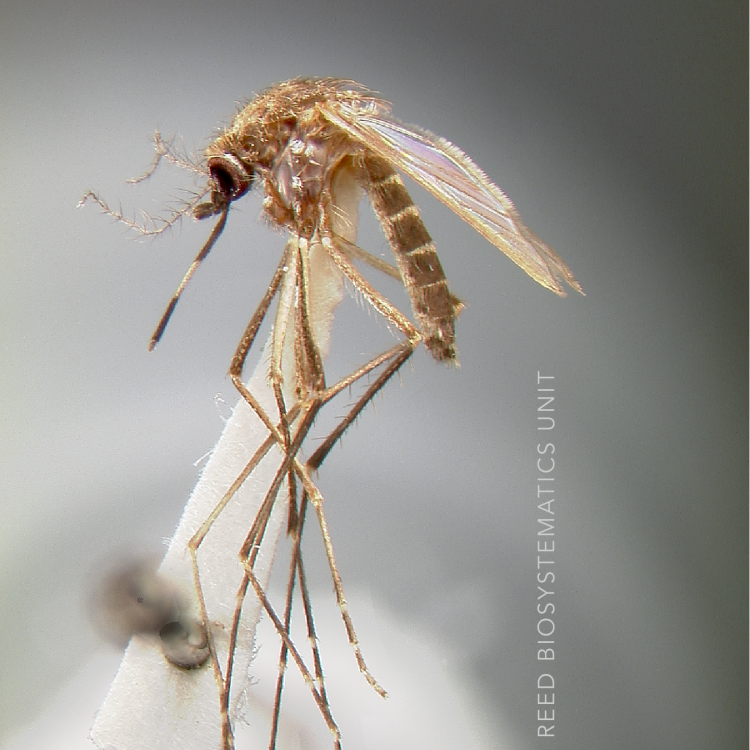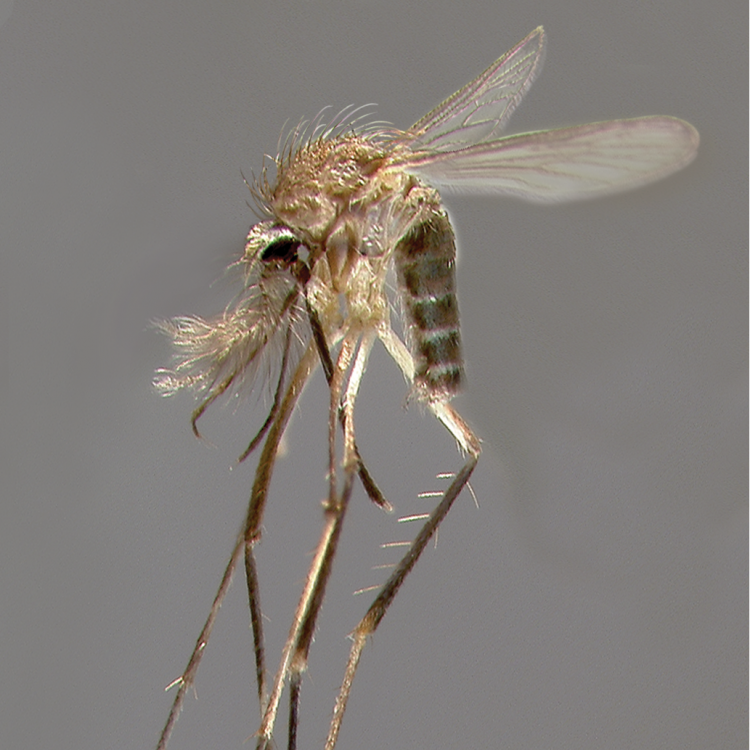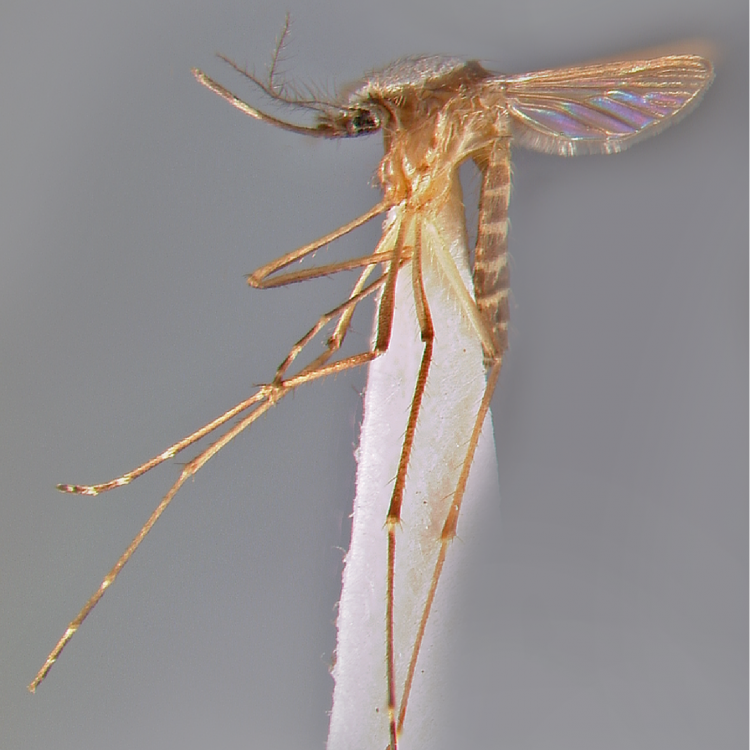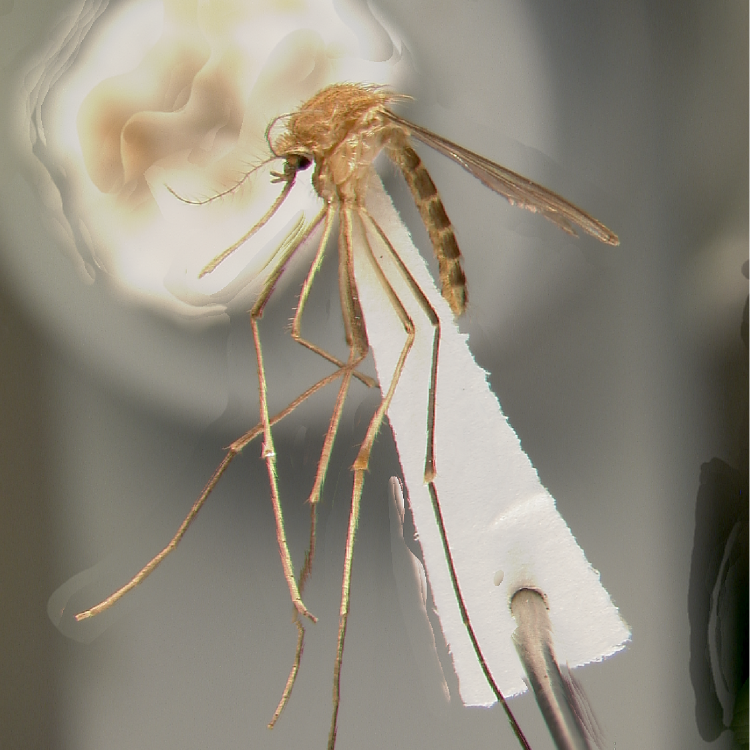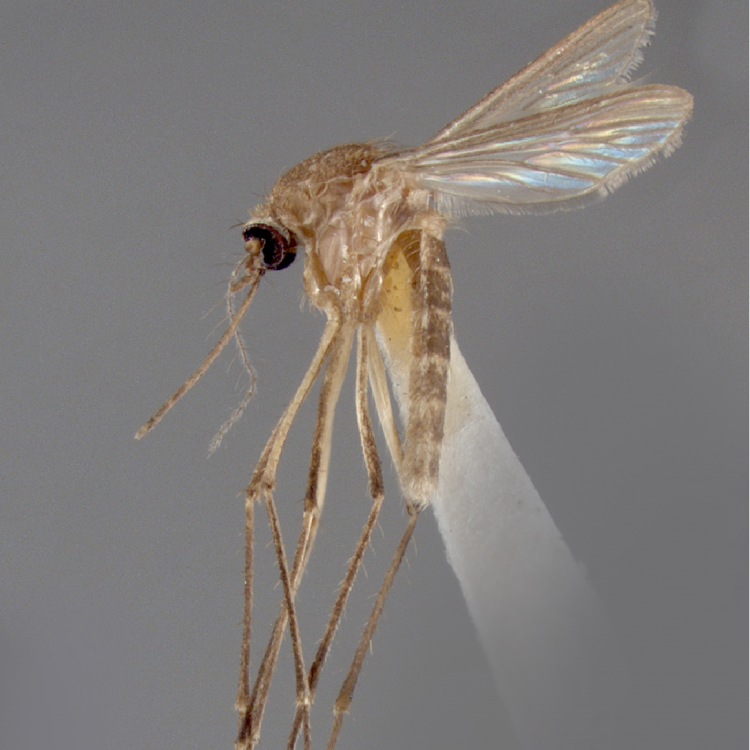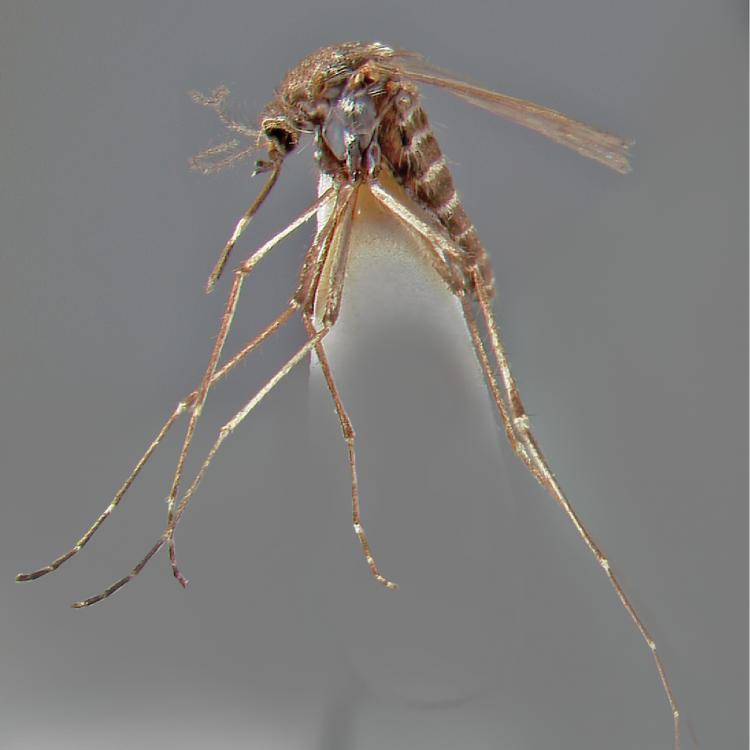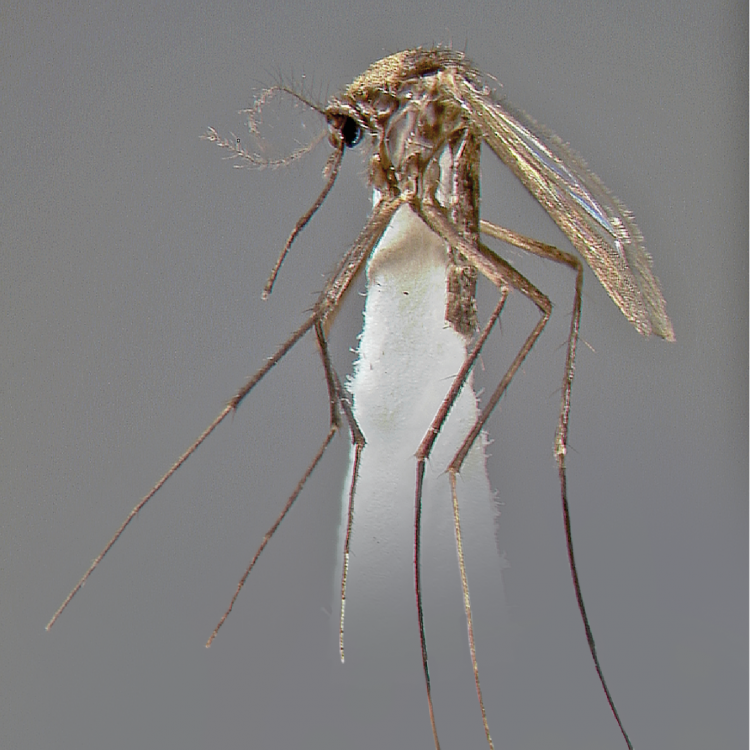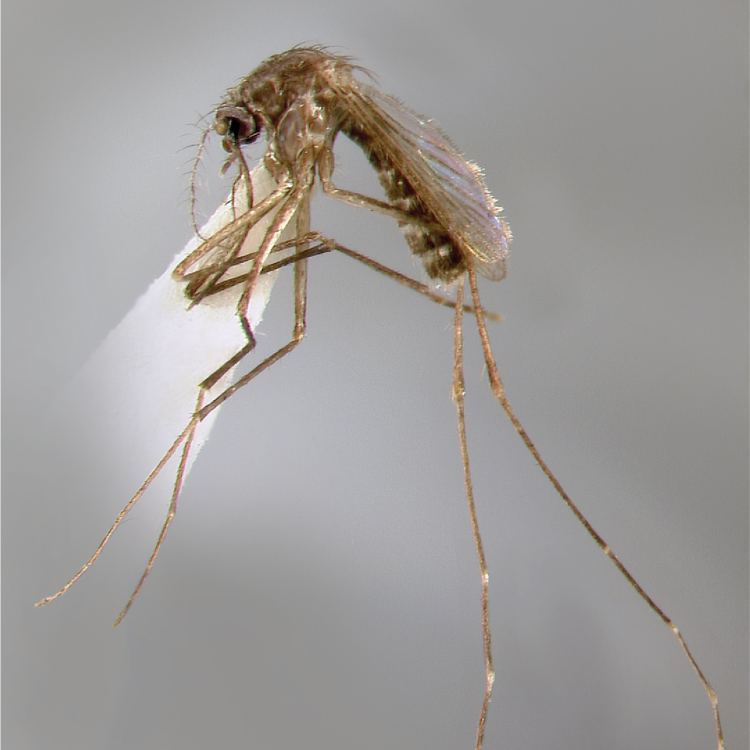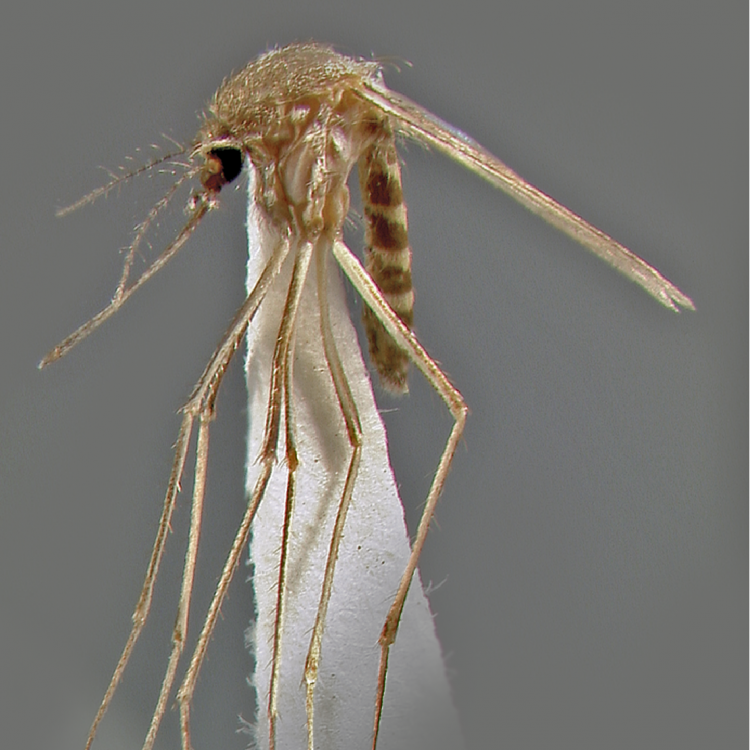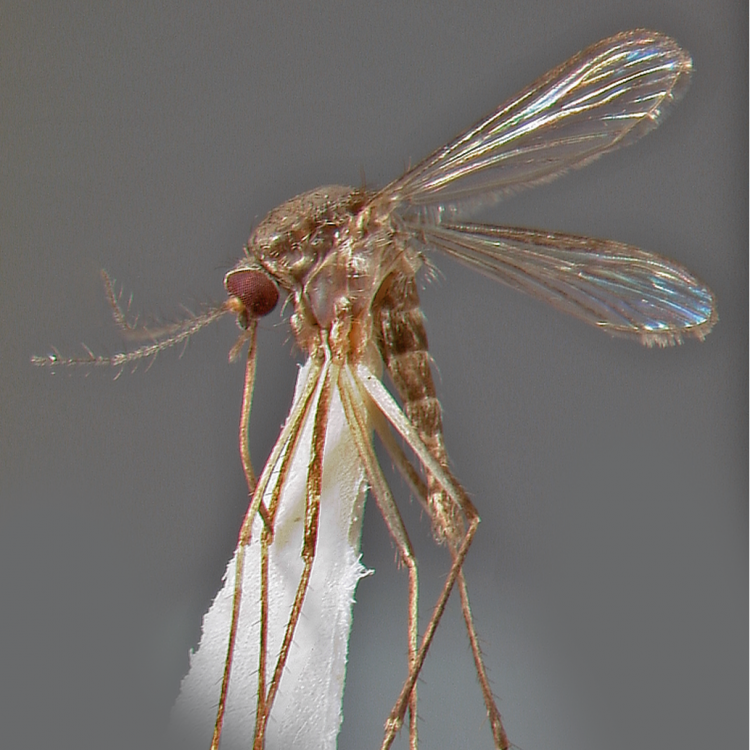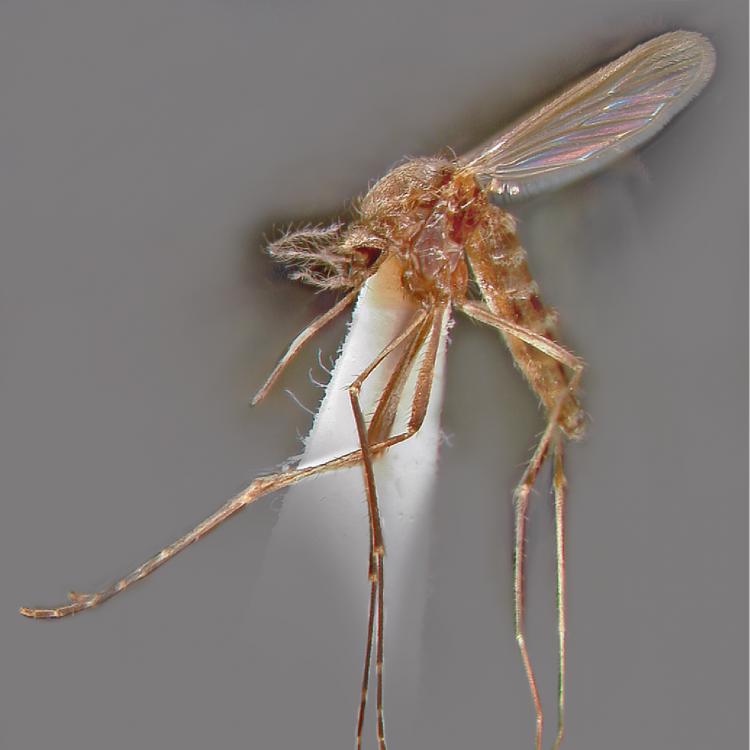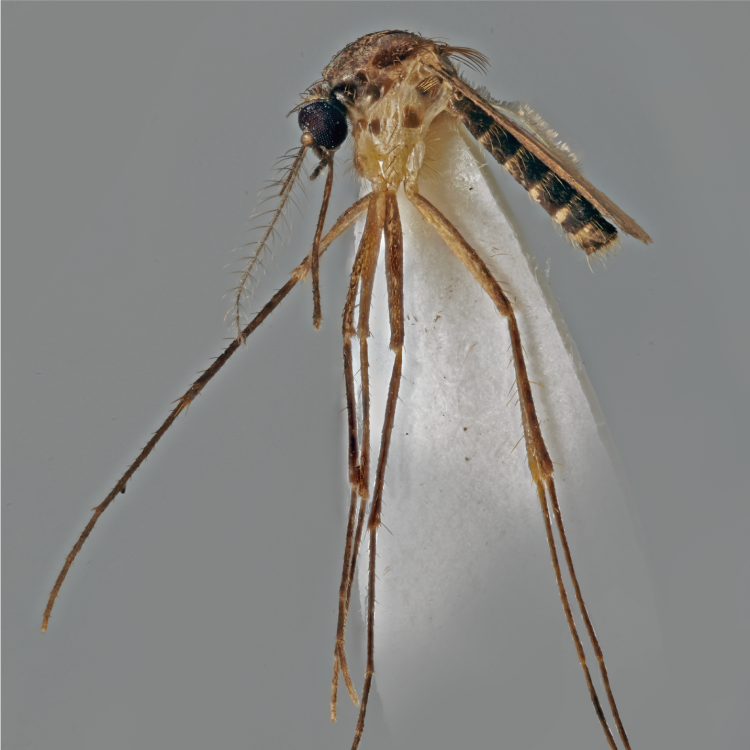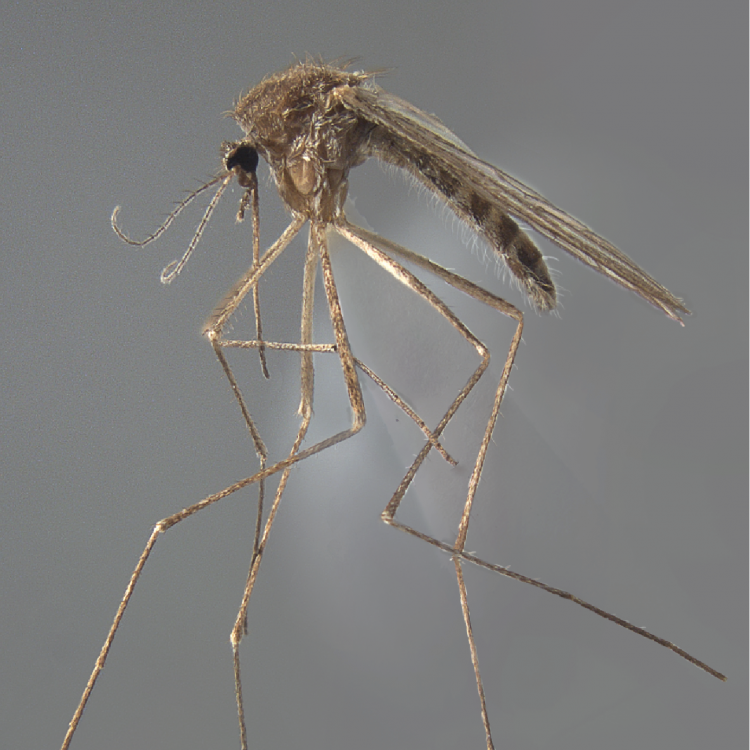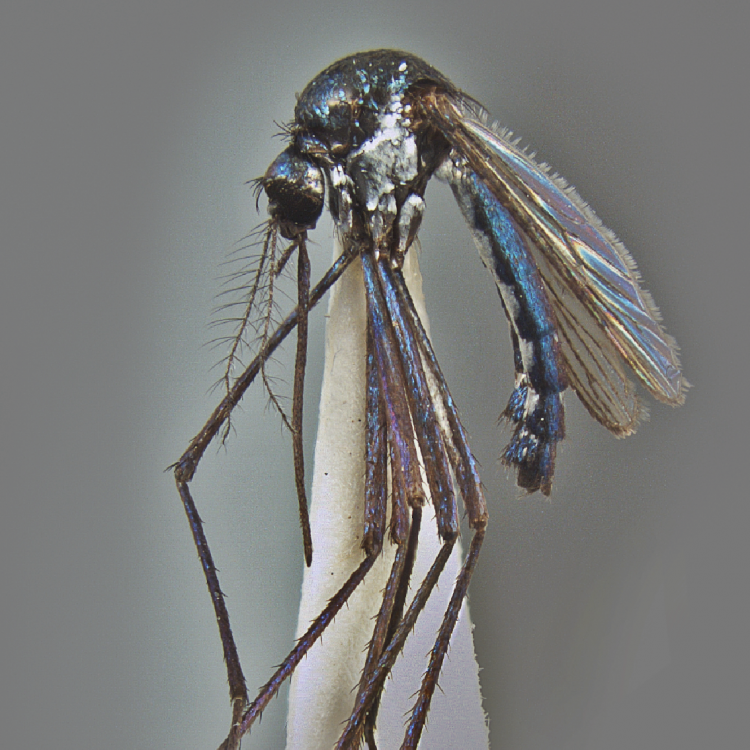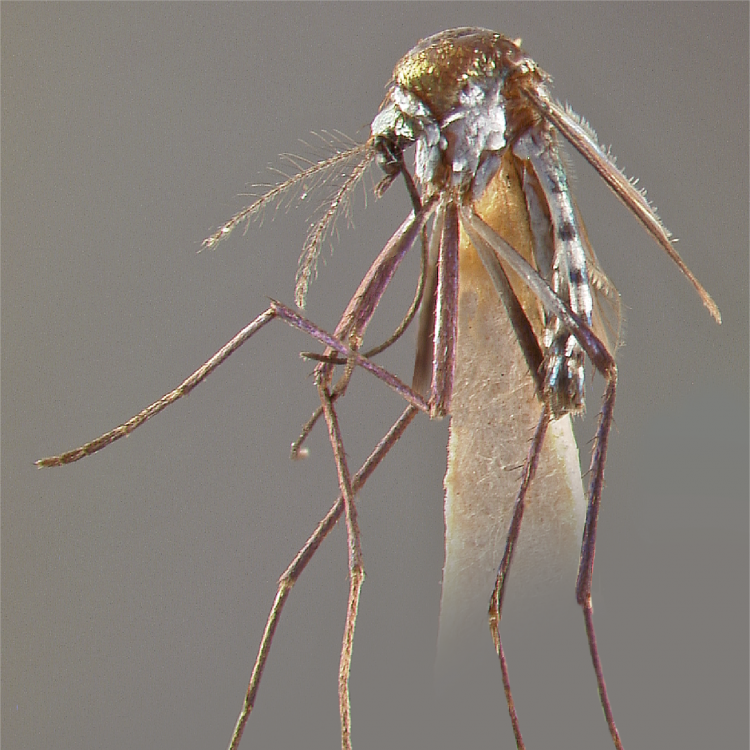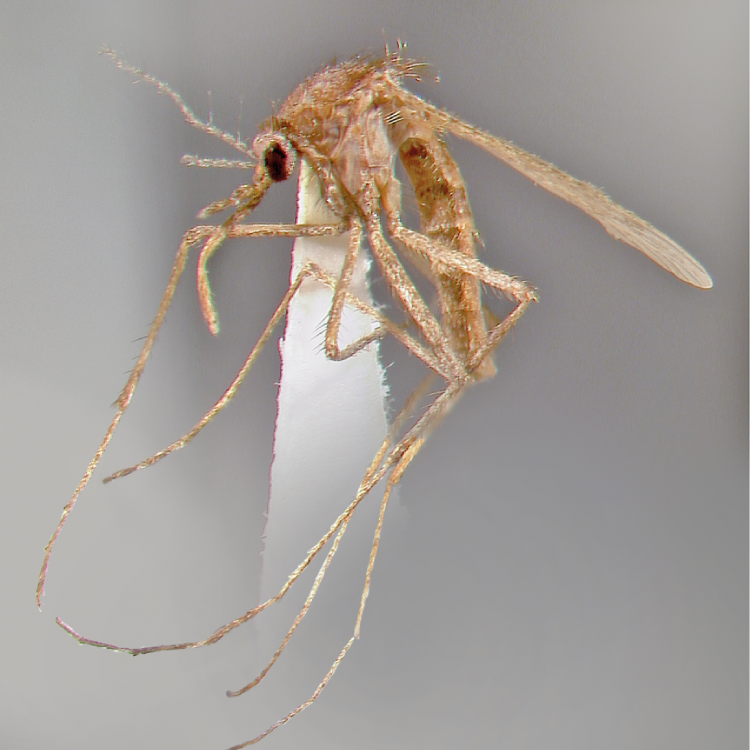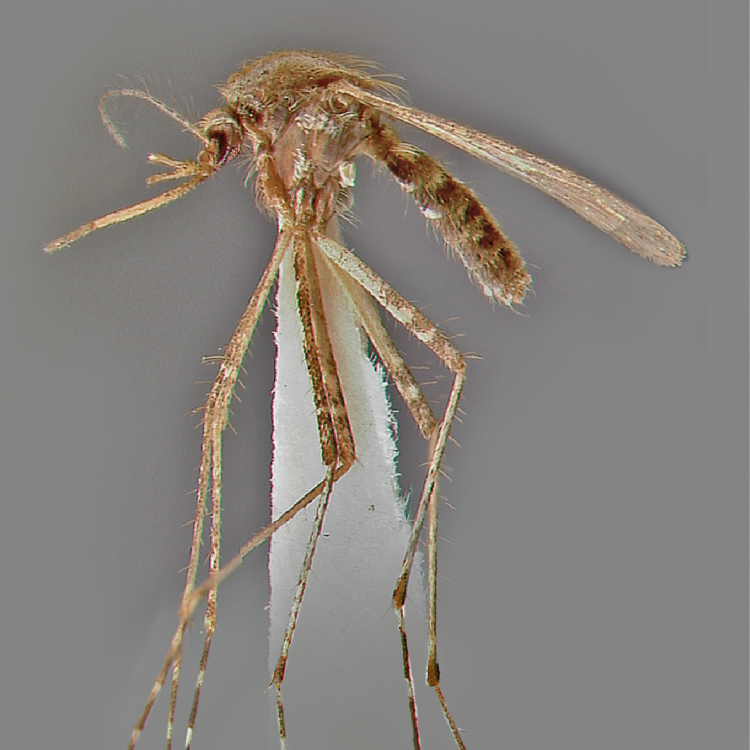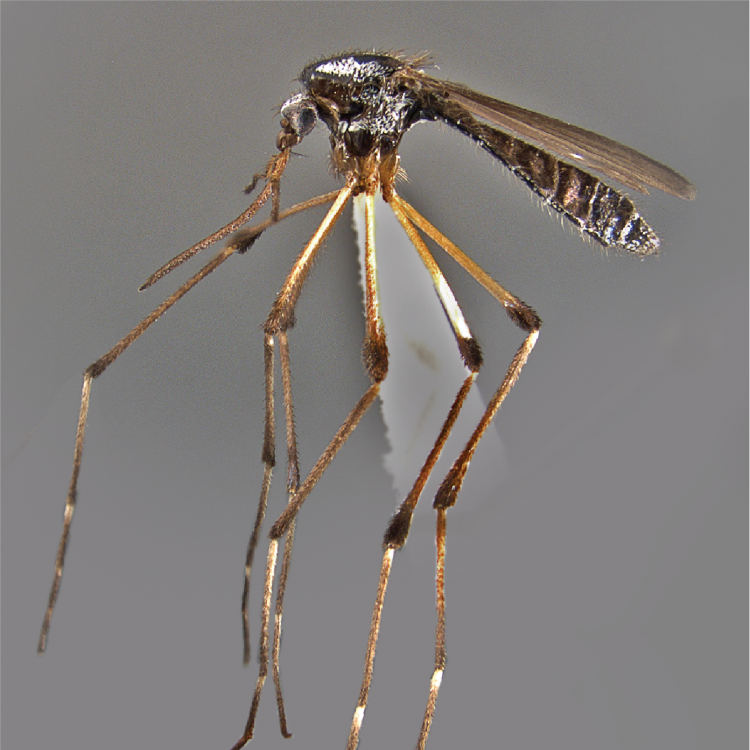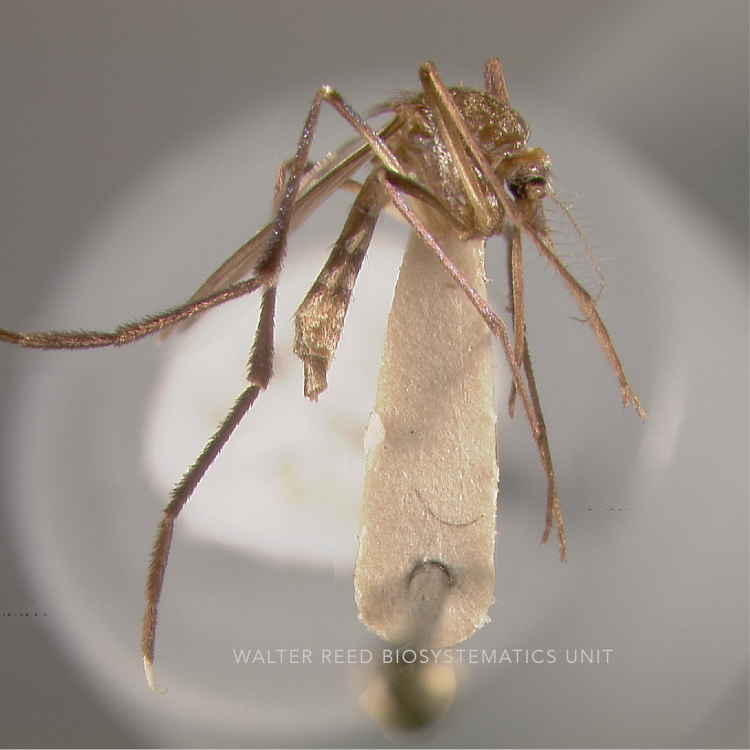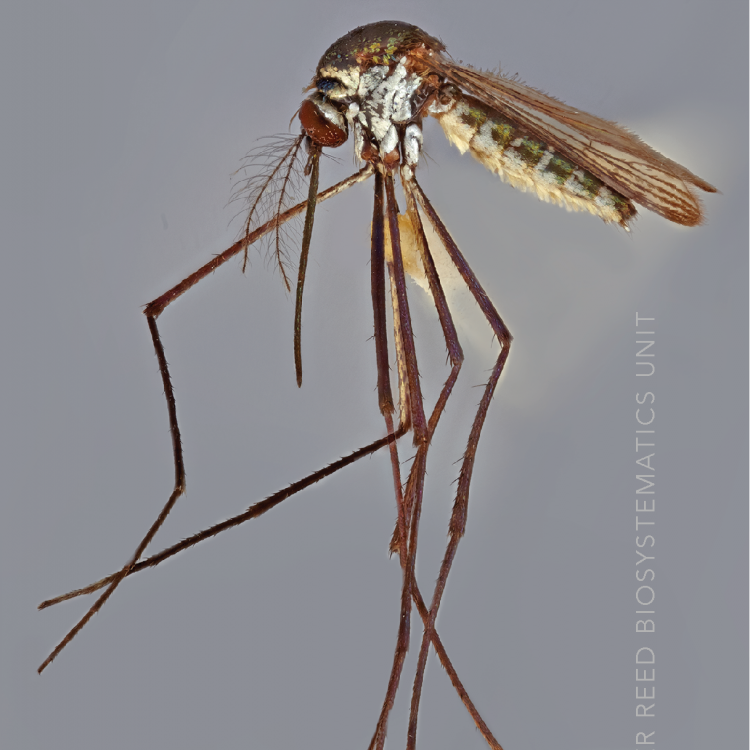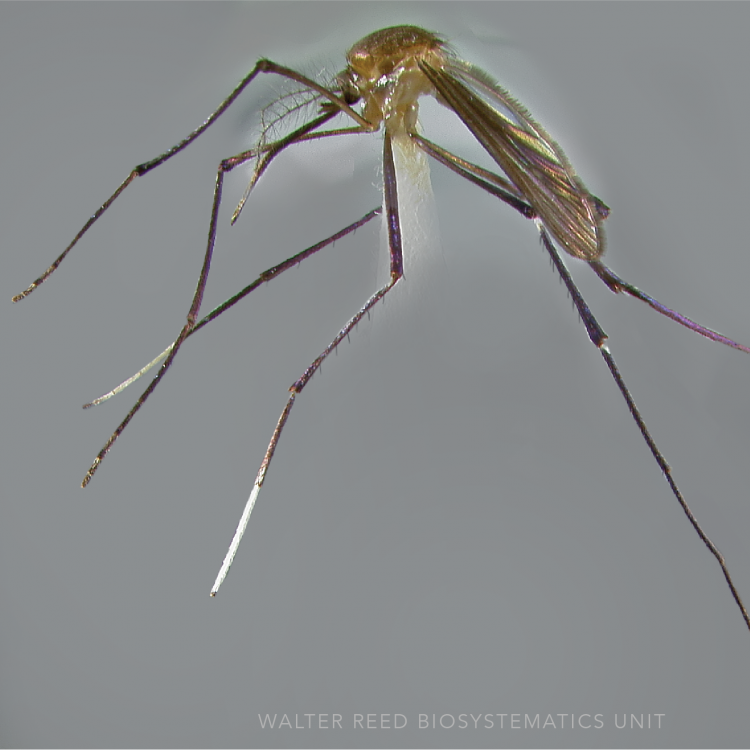GLOBAL DISTRIBUTION
Etymology: five banded (L); “abdomen cinereous; tergum with five black, broad, fasciae”
Together with Cx. pipiens Linneaus, Cx. quinquefasciatus belongs to the Pipiens Subgroup. It has a complex taxonomic history and 40 valid synonyms. The male genitalia is the only reliable morphological character to differentiate these two species. Hybridization is frequent where the two species ranges overlap, typically sub-tropical to temperate zones. Hybrid offspring often display characteristics of both species. Culex quinquefasciatus is commonly found in tropical to sub-tropical climates and reports from temperate zones may be Cx. pipiens hybrids.
Type locality: Mississippi River, United States
Type depository: Type non-existent (NE)
DIAGNOSTIC CHARACTERS (Click photos to view; mouse over and click large photo to zoom in.)
ADULT (illustrated): Head: Head: Proboscis without distinct median pale band. Thorax: Postspiracular scales absent; prealar scales absent; lower mesepimeron with one seta; C-I with a few dark scales; scutal integument yellowish or pale brown. Legs: Ta-I–III entirely dark. Anterior surface of Fe-I, Fe-II and Ti-I–III without median longitudinal pale stripes. Wings: Wing entirely dark-scaled; vein R2+3 short, <0.25 length of cell R2. Abdomen: Terga bands with pale yellowish basal bands; abdominal sterna not banded.
LARVA (not illustrated): Head: Seta 1-C relatively long, slender; seta 5-C usually 4–8 branched; setae 5,6-C 4–6 branched. Thorax: Seta 1-M usually single. Abdominal segments: Sum of branches of seta 1-III–IV on one side <10; seta 1-III,IV usually double, relatively short, not reaching margin of following segment; seta 6-VI usually double. Terminal segments: Comb with comb scales evenly fringed from sides to apex; siphon/saddle index <3.5; siphon wider medially; pecten with 10–18 pecten spines (PS); distal PS with 2–5 basal denticles; seta 1-S relatively long, longer than diameter of siphon (S) at point of insertion; seta 1-S usually with 4 pairs, 1a-S near distal pecten spine, 1c-S not in line with other setae; seta 1-X usually single.
TAXONOMIC KEYS
Carpenter & LaCasse 1955
Dodge 1966
Ramalingam 1976
Bohart & Washino 1978
Harbach 1988
Lee et al. 1989a
Darsie & Pradhan 1990
Jupp 1996
Tanaka 2004a
Rattanarithikul et al. 2005
Darsie & Ward 2005
Becker et al. 2010
Harrison et al. 2016
![]()
WRBU – Culex (Cux.) - Neotropical Region – Larva
![]()
WRBU – Culex (Cux.) - Eastern Palearctic Region – Adult
![]()
WRBU – Culex (Cux.) - Eastern Palearctic Region – Larva
![]()
WRBU – Culex (Cux.) - Afrotropical Region (East Africa) - Adult
![]()
WRBU – Culex (Cux.) - Afrotropical Region (West Africa) - Adult
Exemplar DNA sequences
Cx. quinquefasciatus COI: KJ012164–65, FJ210909–10, FJ210901, KJ012166–73, KJ012162
Cx. quinquefasciatus whole genome: GCF_000209185.1
BIONOMICS
Immatures
Culex quinquefasciatus immatures are commonly associated with humans in both domestic and peri-domestic habitats. Typical habitats are organically rich waters, including sewers, ground pools, ditches, agriculture seepage pits, and sewage treatment plant holding tanks. Female Cx. quinquefasciatus lay their eggs in loosely cemented oval rafts of ˜100 eggs. The eggs are highly sensitive to desiccation, and normally hatch within 24–30 hours.
Adults
After emergence, both males and females take sugar meals from plants. Culex quinquefasciatus is autogenous, and females are able to lay their first batch of eggs without needing a blood meal. Although primarily anthropophilic and closely associated with humans, Cx. quinquefasciatus will feed opportunistically on a wide variety of hosts, including birds, domestic animals and small mammals. Females feed mostly at night, both indoors and outdoors.
DISTRIBUTION NOTES
Afghanistan, Algeria, Angola, Anguilla, Antigua & Barbuda, Aruba, Argentina, Australia, Bahamas, Bahrain, Bangladesh, Barbados, Belize, Bolivia, Bonaire, Brazil, British Indian Ocean Territory, Borneo, Burkina Faso, Cambodia, Cameroon, Cayman Islands, Central African Republic, Chile, Colombia, Comoros, Congo, Cook Islands (Polynesia), Costa Rica, Cote d'Ivoire, Croatia, Cuba, Curacao, Djibouti, Dominica, Dominican Republic, Ecuador, Egypt, El Salvador, Equatorial Guinea, Ethiopia, Fiji, France, French Guiana, French Polynesia, Gabon, Gambia, Ghana, Greece, Grenada, Guadeloupe, Guam, Guatemala, Guyana, Haiti, Honduras, Hong Kong, India, Indonesia, Iran, Iraq, Israel (and Gaza Strip & West Bank), Jamaica, Japan, Jordan, Kenya, Kiribati, Kuwait, Laos, Liberia, Madagascar (includes Glorioso & Juan De Nova Is), Malaysia, Maldives, Mali, Mariana Islands, Marshall Islands, Martinique, Mauritania, Mauritius, Mexico, Micronesia (Wake Island), Montserrat, Morocco, Mozambique, Myanmar, Nauru, Nepal, New Caledonia, New Hebrides, New Zealand, Nicaragua, Niger, Nigeria, Oman, Pakistan, Palau, Panama, Papua New Guinea, Paraguay, People's Republic of China, Peru, Philippines, Puerto Rico, Republic of South Africa, Reunion, Russia, Saint Kitts & Nevis, Saint Lucia, St. Vincent & the Grenadines, Samoa (Ind. State of Samoa; American Samoa; Western Samoa), São Tomé & Príncipe, Saudi Arabia, Sint Maarten, Senegal, Singapore, Solomon Islands, Somalia, South Korea, Sri Lanka, Sudan & South Sudan, Suriname, Taiwan, Tanzania, Thailand, Timor, Togo, Tonga, Trinidad & Tobago, Turkey, Tuvalu, Uganda, United States (continental, Hawaiʻi), Uruguay, Vanuatu, Venezuela, Vietnam, Virgin Islands, Yemen, Zambia.

WRBU VECTOR HAZARD REPORTS
VHR: Southern US and Northern Mexico
VHR: Mosquito Activity Forecast US-Mexico Border October 2019
View other WRBU Vector Hazard Reports
Available GIS Models:
Cx_quinquefasciatus_Nyari_1 Global
Cx_quinquefasciatus_Samson_1 South & Central America
IMPORTANT REFERENCES (full citations below)
Say 1823: 10 (A; as sp.)
Giles 1902 (F*) (as fatigans Wiedemann)
Banks 1908 (F*, P*, L*, E*; as fatigans)
Bancroft 1908: 31 (M, F; "House Mosquito"; as fatigans)
Bancroft 1908: 50 (M, F; as genus Taeniorhynchus acer; "Golden Mosquito")
Macfie & Ingram 1922 (F*) (as fatigans)
Barraud 1924m (L*; as fatigans); Gerry 1932 (F*)
Bohart & Ingram 1946b (M*, L*; bionomics)
LaCasse & Yamaguti 1950: 220 (M*, F*, L*; bionomics, distribution, taxonomy)
Darsie 1951: 35 (P*)
Christophers 1951 (F*)
Yamaguti & LaCasse 1951c: 49 (M*, F*, L*)
Carpenter & LaCasse 1955: 286 (M*, F*, L*; keys)
Iyengar & Menon 1955 (distribution)
Mattingly & Brown 1955: 86 (taxonomy)
Barr 1957: 153 (taxonomy)
Karisa, et al. 2021 (bionomics)
Bohart 1957 (1956): 77 (M*, F, L*)
Bohart & Washino 1957: 463 (L*)
Hara 1957: 55 (F*)
Stone 1957 (1956)a: 342 (taxonomy)
Belkin 1962: 195 (M*, F, P*, L*; taxonomy)
Belkin 1962: 8 (distribution)
Belkin et al. 1966: 4 (restriction of type locality)
Dodge 1966: 370 (1st instar L*; key)
Bram 1967b: 192 (M*, F*, P*, L*; bionomics, distribution, taxonomy; as pipiens subspecies)
Belkin 1968a: 68 (M, F, P, L; taxonomy, distribution)
Belkin et al. 1970: 73 (M*, F, P*, L*; as species)
Basio 1971b: 57 (M*; bionomics; as pipiens subspecies)
Lambrecht & van Someren 1971: 483 (distribution)
Baisas 1974: 95 (M, F*, P, L*; taxonomy, bionomics, distribution; Philippines)
White 1975: 319 (taxonomy)
Tanaka et al. 1975c: 219 (distribution)
Sirivanakarn 1976: 30 (M*, F*, P*, L*; distribution; as valid species)
Ramalingam 1976: 307 (taxonomy, bionomics, keys., distribution; Samoa & Tonga)
Belkin 1977b: 45 (nomenclatural review)
Iglisch 1977: 271 (M*)
Brunhes 1977a (distribution; Comoros Island)
Rodhain et al. 1977 (distribution)
Taylor & Maffi 1978: 182 (distribution)
Sirivanakarn & White 1978: 362 (M*, F*, P*, L*; neotype designation)
Bohart & Washino 1978: 126 (M*, F, L*; keys, distribution)
Tanaka et al. 1979: 141 (M*, F*, L*; as pipiens subspecies)
Harbach, Dahl & White 1985 (F*)
Ahmed 1987 (distribution; Bangladesh)
Zaim 1987: 568 (distribution)
Harbach 1988: 31 (M*, F, P*, L*; taxonomy, complete synonym, keys, bionomics, distribution)
Lee et al. 1989a: 166 (F key, taxonomy, bionomics, distribution, review)
Darsie & Pradhan 1990 (F, L; taxonomy, keys, bionomics, distribution; Nepal)
Suleman et al. 1993 (distribution; Pakistan)
Abdullah & Merdan 1995 (distribution; Saudi Arabia)
Jupp 1996 (M*, F*; key)
Whelan & Hapgood 2000 (bionomics, distribution; East Timor)
Pena et al. 2003 (distribution; Dominican Republic)
Ree 2003: 40 (distribution; remove Korea)
Rossi & Martínez 2003: 472 (distribution; Uruguay)
Toto et al. 2003: 344 (distribution; Equatorial Guinea)
Derraik 2004 (distribution; New Zealand)
Tanaka 2004a: 17 (P*; taxonomy, key)
Rattanarithikul et al. 2005 (F*, L*; bionomics, distribution, keys)
Darsie & Ward 2005 (F*, L*; keys, distribution)
Suman et al. 2008 (E*)
Becker et al. 2010: 278 (M*, F*, L*; keys, taxonomy, distribution, bionomics)
Berti et al. 2015 (distribution; Venezuela)
Harrison et al. 2016 (F*, L*; keys, distribution; notes 10, 24)
Lutz, et al. 2020 (bionomics)
CURRENT SYNONYMS
syn. fatigans Wiedemann
1828: 10 (M, F). Type locality: East Indies [Indonesia] (NMW). References: Séguy 1924: 36 (M gen.*); Barraud 1934: 420 (M*, F, L*); Edwards 1941: 316 (M*, F*), 421 (P); Lane 1953: 344 (M*, F*, P*, L*); Dobrotworsky 1965: 215 (M*, F, L*); Stone 1957 (1956)a: 342 (synonymy); Dobrotworsky 1955b: 41 (hybridization studies); Belkin 1968a: 68 (lectotype designation).
syn. aestuans Wiedemann
1828: 11 (M, F). Type locality: Salvador, Bahia, Brazil (NMW). References: Stone 1958a: 186 (lectotype designation; synonymy); Belkin 1968b: 12 (tax.); Belkin et al. 1971: 22 (type loc. info.).
syn. pungens Wiedemann
1828: 9 (F). Type locality: New Orleans, [Louisiana, United States] (NMW). References: Belkin 1968b: 19 (lectotype designation).
syn. acer Walker
1848: 8 (F). Type locality: New Zealand (NHMUK).
syn. cingulatus Doleschall
1856: 405 (A). Type locality: Ambarawa, Java [Indonesia] (LU).
syn. cubensis Bigot
1857: 329 (A). Type locality: Cuba (MNHP). References: Edwards 1932a: 208 (syn. with fatigans); Belkin 1968b: 15 (tax., lectotype designation).
syn. anxifer Bigot
1859: 117 (M*, F*). Type locality: Madagascar (LU).
syn. serotinus Philippi
1865: 595 (M, F). Type locality: Santiago & Valdivia, Chile (NE).
syn. autumnalis Weyenbergh
1882: 23 (M*, F*, P*, L*). Type locality: Primero River, Cordoba, Argentina (?Universidad de Cordoba).
syn. penafieli Sánchez
1885: 213 (M, F; description). Type locality: Mexico City, Mexico (LU). References: Sánchez 1886: 326 (name given).
syn. macleayi Skuse
1889: 1746 (F). Type locality: King George's Sound, Western Australia, Australia (ANIC). References: Lee et al. 1989a: 166 (type information).
syn. skusii Giles
1900a: 292 (M, F). Type locality: Australia (LU).
syn. doleschallii Giles
1900a: 338 (new name for cingulatus Doleschall not Fabricius, 1805).
syn. quasipipiens Theobald
1901c: 136 (F*). Type locality: Sambalpur, Central Provinces, India (NHMUK). References: Bram 1967c (type information; lectotype designation).
syn. fouchowensis Theobald
1901c: 137 (M*, F*). Type locality: Foochow, [Fukien], China [People's Republic of China] (NHMUK).
syn. reesii Theobald
1901c: 145 (M*, F*). Type locality: Hong Kong [People's Republic of China] (NHMUK).
syn. sericeus Theobald
1901c: 147 (F*). Type locality: Hong Kong [People's Republic of China] (LU).
syn. luteoannulatus Theobald
1901c: 159 (A; fatigans subspecies). Type locality: None designated (NHMUK).
syn. trilineatus Theobald
1901c: 159 (A; fatigans subspecies). Type locality: None designated (LU).
syn. albolineatus Giles
1901a: 609 (A). Type locality: Shahjahanpur, [United Provinces], India (NHMUK). References: Sirivanakarn 1976: 33 (lectotype designation).
syn. pallidocephala Theobald
1904b: 73 (F). Type locality: Sennar, Blue Nile, Sudan (NHMUK). References: Edwards 1941: 316 (synonymy).
syn. cartroni Ventrillon
1905b: 429 (M, F). Type locality: Majunga, Moroudara, Madagascar (MNHP). References: Harbach 1988: 31 (lectotype designation).
syn. barbarus Dyar & Knab
1906d: 210 (L*). Type locality: Trinidad [Trinidad & Tobago] (USNM).
syn. zeltneri Neveu-Lemaire
1906: 251 (M*, F*). Type locality: Harar, [Hararge], Ethiopia (NE). References: Edwards 1941: 353 (tax.); White 1975: 322 (syn.).
syn. pygmaeus Neveu-Lemaire
1906: 256 (M*, F*). Type locality: Imi, [Ogaden], Ethiopia (NE).
syn. didieri Neveu-Lemaire
1906: 257 (F*). Type locality: Leopoldville, Belgian Congo [Kinshasa, Democratic Republic of Congo] (NE).
syn. raimondii Tamayo
1907: 36 (M*, F*, P*, L*). In: Tamayo & García 1907. Type locality: Huacachina [desert oasis], [Ica], Peru (LU).
syn. quasilinealis Theobald
1907: 415 (F). Type locality: Adelaide, [South Australia], Australia (NHMUK).
syn. stoehri Theobald
1907: 419 (F*). Type locality: British Central Africa [Malawi] (NHMUK).
syn. christophersii Theobald
1907: 453 (M, F). Type locality: India (NHMUK). References: Bram 1967c (type info.; lectotype designation).
syn. minor Theobald
1908b: 298 (M, F). Type locality: Sylhet & Lungleh, Lushai Hills, Assam & Calcutta, Bengal, India (NHMUK).
syn. aikenii Dyar & Knab
1908: 61 (M). Type locality: New Amsterdam, Surinam (USNM). References: Edwards 1932a: 208 (syn, with fatigans); Stone & Knight 1957a: 43 (lectotype designation).
syn. revocator Dyar & Knab
1909d: 256 (A). Type locality: Hope Gardens, Newcastle, [Surrey], Jamaica (USNM). References: Stone & Knight 1957a: 55 (lectotype designation).
syn. lachrimans Dyar & Knab
1909d: 259 (new name for aikenii Dyar & Knab, not Aiken & Rowland, 1906).
syn. goughii Theobald
1911b: 268 (syntype M only). Type locality: Onderstepoort, Transvaal [Republic of South Africa] (NHMUK). References: White 1975: 321 (lectotype designation; F, paralectotype = univittatus).
syn. fuscus Taylor
1914c: 699 (M; Culicelsa). Type locality: Townsville, Queensland, Australia (NE).
syn. aseyehae Dyar & Knab
1915: 112 (M, F). Type locality: New Providence Island, Bahama Islands (USNM). References: Stone & Knight 1957a: 43 (lectotype designation).
syn. townsvillensis Taylor
1919: 836 (new name for fuscus Taylor, 1914c, not Theobald, 1909b).
syn. hensemaeon Dyar
1920h: 178 (F). Type locality: Los Banos, [Laguna, Luzon], Philippines (USNM).
syn. nigrirostris Enderlein
1920: 51 (F; fatigans variety). Type locality: Tananarive, Madagascar (ZM).
CITED REFERENCES
Abdullah, M.A.R., & Merdan, A.I. (1995). Distribution and ecology of the mosquito fauna in the southwestern Saudi Arabia. Journal of the Egyptian Society of Parasitology, 25(3), 815–837.
Ahmed, T.U. (1987). Checklist of the mosquitoes of Bangladesh. Mosquito Systematics, 19(3), 187–200.
Baisas, F. E. (1974). The mosquito fauna of Subic Bay Naval Reservation, Republic of the Philippines. San Francisco: Headquarters, First Medical Service Wing (PACAF), San Francisco.
Bancroft, T. L. (1908). List of the mosquitoes of Queensland, with the original descriptions and notes on the life-history of a number. Annals of the Queensland Museum, 8, 1–64.
Banks, C. S. (1908). Biology of Philippine Culicidae. Philippine Journal of Science, 3(4), 235–258.
Barr, A.R. (1957). The distribution of Culex pipiens and C. p. quinquefasciatus in North America. American Journal of Tropical Medicine and Hygiene, 6(1), 153–165.
Barraud, P. J. (1924m). A revision of the culicine mosquitoes of India. Part XVII. Indian Journal of Medical Research (Calcutta), 12, 427–434.
Basio, R. G. (1971b). The mosquito fauna of the Philippines (Diptera, Culicidae). Manila: National Museum of the Philippines. 198pp.
Becker, N., Petrić, D., Zgomba, M., Boase, C., Madon, M., Dahl, C., & Kaiser, A. (2010). Mosquitoes and their control (Second ed.). Berlin Heidelberg: Springer-Verlag.
Belkin, J.N. (1962). The mosquitoes of the South Pacific (Diptera, Culicidae) (Vols. 1 & 2). Berkeley, California: University of California Press.
Belkin, J.N. (1968a). Mosquito studies (Diptera, Culicidae) VII. The Culicidae of New Zealand. Contributions of the American Entomological Institute, 3(1), 1–182.
Belkin, J.N. (1977b). Quinquefasciatus or fatigans for the tropical (southern) house mosquito (Diptera: Culicidae). Proceedings of the Entomological Society of Washington, 79(1), 45–52.
Belkin, J.N., Heinemann, S.J., & Page, W.A. (1970). The Culicidae of Jamaica (Mosquito studies. XXI). Contributions of the American Entomological Institute, 6(1), 458.
Belkin, J.N., Schick, R.X., & Heinemann, S.J. (1966). Mosquito studies (Diptera: Culicidae). VI. Mosquitoes originally described from North America. Contributions of the American Entomological Institute, 1(6), 1–39.
Berti, J., Guzmán, H., Estrada, Y., & Ramírez, R. (2015). New records of mosquitoes (Diptera: Culicidae) from Bolívar State in South Eastern Venezuela, with 27 new species for the state and 5 of them new in the country. Frontiers in Public Health, 2, 10.
Bigot, J.M.F. (1857). In Historia fisica, politica y natural de la isla de Cuba., Pages: 328–332.
Bigot, M.J. (1857). Orden de los Dipteros. In R. de la Sagra (Ed.), Historia fisica, politica y natural de la Isla de Cuba (Vol. 7, pp. 328–349). Paris.
Bigot, M.J. (1859). Diptères de Madagascar. Première partie. Annales de la Société Entomologique de France, 7, 115–135.
Bohart, R.M. (1957). Insects of Micronesia (Diptera: Culicidae) (Vol. 12). Honolulu, Hawaii Bishop Museum, Honolulu.
Bohart, R.M. & Washino, R.K. (1978). Mosquitoes of California (3rd ed.). Berkeley, CA: University of California, Agriculture and Natural Resources.
Bohart, R.M., & Ingram, R.L. (1946b). Mosquitoes of Okinawa and islands in the Central Pacific. In United States NAVMED (Bureau of Medicine and Surgery, Navy Department) (pp. 110). Washington.
Bohart, R.M., & Washino, R.K. (1957). Differentiation of second and third stage larvae of California Culex (Diptera: Culicidae). Annals of the Entomological Society of America, 50, 459–463.
Bram, R.A. (1967b). Contributions to the mosquito fauna of Southeast Asia. II. The genus Culex in Thailand (Diptera: Culicidae). Contributions of the American Entomological Institute, 2(1), 1–296.
Brunhes, J. (1977a). Les moustiques de l'archipel des Comores I. Inventaire, repartition et description de quatre espèces ou sous-espécies nouvelles. Cahier ORSTOM. Série Entomologie Médicale et Parasitologie, 15(2), 131–152.
Carpenter, S.J., & LaCasse, W.J. (1955). Mosquitoes of North America (North of Mexico). Berkeley, Los Angeles: University of California Press.
Christophers, S.R. (1951). Note on morphological characters differentiating Culex pipiens L. from Culex molestus Forskål and the status of these forms. Transactions of the Royal Entomological Society of London, 102, 372–379.
Darsie, R.F., Jr. (1951). Pupae of the culicine mosquitoes of the Northeastern United States (Diptera, Culicidae, Culicini). Ithaca, NY: Cornell University Agricultural Experiment Station Memoir 304.
Darsie, R.F., Jr., & Pradhan, S.P. (1990). The mosquitoes of Nepal: Their identification, distribution and biology. Mosquito Systematics, 22(2), 69–130.
Darsie, R.F., Jr., & Ward, R.A. (2005). Identification and geographical distribution of the mosquitoes of North America, North of Mexico. Gainesville, FL: University Press of Florida.
Derraik, J.G.B. (2004). Exotic mosquitoes in New Zealand: A review of species intercepted, their pathways and ports of entry. Australian and New Zealand Journal of Public Health, 28(5), 433–444.
Dodge, H. R. (1966). Studies on mosquito larvae II. The first-stage larvae of North American Culicidae and of world Anophelinae. Canadian Entomologist, 98, 337–393.
Doleschall, C.L. (1856). Eerste bijdrage tot de kennis der dipterologische fauna. Natuurkundig Tijdschrift voor Nederlandsch Indie, 10, 403–414.
Dyar, H.G. (1920h). A collection of mosquitoes from the Philippine Islands (Diptera, Culicidae). Insecutor Inscitiae Menstruus, 8, 175–186.
Dyar, H.G., & Knab, F. (1906d). The larvae of Culicidae classified as independent organisms. Journal of the New York Entomological Society, 14, 169–230.
Dyar, H.G., & Knab, F. (1908). Descriptions of some new mosquitoes from tropical America. Proceedings of the United States National Museum, 35(1632), 53–70.
Dyar, H.G., & Knab, F. (1909d). Descriptions of some new species and a new genus of American mosquitoes. Smithsonian Miscellaneous Collections, 52(1822), 253–266.
Dyar, H.G., & Knab, F. (1915). Notes on the species of Culex of the Bahamas. Insecutor Inscitiae Menstruus, 3, 112–115.
Enderlein, G. (1920). Die culiciden-fauna Madagascars. Wiener Entomologische Zeitung, 38, 47–52.
Giles, G. M. (1900a). A handbook of the gnats or mosquitoes giving the anatomy and life history of the Culicidae. J Bale and Sons and Danielsson, Ltd London.
Giles, G.M. (1901a). A plea for the collective investigation of Indian Culicidae with suggestions as to moot points for enquiry, and a prodromus of species known to the author. Journal of the Bombay Natural History Society, 13, 592–610.
Giles, G.M. (1902). A handbook of the gnats or mosquitoes giving the anatomy and life history of the Culicidae, together with descriptions of all species notices up to the present date. J. Bale, sons & Danielsson, Limited, London, 530pp.
Hara, J. (1957). Studies on the female terminalia of Japanese mosquitoes. Japanese Journal of Experimental Medicine, 27, 45–91.
Harbach, R.E. (1988). Mosquitoes of the subgenus Culex in southwestern Asia and Egypt (Diptera: Culicidae). Contributions of the American Entomological Institute, 24(1), 1–240.
Harbach, R.E., Dahl, C., & White, G.B. (1985). Culex (Culex) pipiens Linnaeus (Diptera: Culicidae): Concepts, type designations, and descriptions. Proceedings of the Entomological Society of Washington, 87(1), 1–24.
Harrison, B.A., Byrd, B.D., Sither, C.B., & Whitt, P.B. (2016). The mosquitoes of the Mid-Atlantic Region: an identification guide (Vol. 1). Madison Heights, MI: Publishing XPress.
Iglisch, I. (1977). Hausmuecken (Culex-pipiens-gruppe) als moegliche Uebertraeger des Serumhepatitis-Virus. Untersuchungen zur Genitalmorphologie. Zeitschrift fuer Angewandte Zoologie, 64(3), 257–290.
Iyengar, M.O.T, & Menon, M.A.U. (1955). Mosquitos of the Maldive Islands. Bulletin of Entomological Research, 46, 1–10.
Jupp, P.G. (1996). Mosquitoes of southern Africa. Culicinae and Toxorhynchitinae. Ekogilde Publishers, Hartebeespoort, South Africa, 156pp.
Karisa, J., Muriu, S., Omuoyo, D., Karia, B., Ngari, M., Nyamwaya, D., ... & Mbogo, C. M. (2021). Urban ecology of arboviral mosquito vectors along the Kenyan coast. Journal of Medical Entomology, 58(1), 428-438.
La Casse, W.J., & Yamaguti, S. (1950). Mosquito fauna of Japan and Korea. Office of the Surgeon General, Headquarters, 8th Army, APO 343. United States. 207th Malaria Survey Detachment.
Lambrecht, F.L., & van Someren, E.C.C. (1971). Mosquitoes of the Chagos Archipelago, Indian Ocean. Southeast Asian J. Southeast Asian Journal of Tropical Medicine and Public Health, 2, 483–485.
Lee, D.J., Hicks, M.M., Debenham, M.L., Griffiths, M., Marks, E.N., Bryan, J.H., & Russell, R.C. (1989a). The Culicidae of the Australasian region. Volume 7. Commonwealth Department of Health, School of Public Health and Tropical Medicine Monograph Series, 2.
Lutz, E. K., Ha, K. T., & Riffell, J. A. (2020). Distinct navigation behaviors in Aedes, Anopheles and Culex mosquito larvae. Journal of Experimental Biology, 223(7).
Macfie, J.W.S., & Ingram, A. (1922). On the genital armature of the female mosquito. Annals of Tropical Medicine and Parasitology, 16, 157–188.
Mattingly, P.F., & Brown, E. S. (1955). The mosquitos (Diptera: Culicidae) of the Seychelles. Bulletin of Entomological Research, 46, 69–110.
Neveu-Lemaire, M. (1906). Étude des culicides africains (mission du Bourg de Bozas en Afrique tropical). Archives de Parasitologie, 10, 238–288.
Pena, C.J., Gonzalvez, G., & Chadee, D. (2003). Seasonal prevalence and container preferences of Aedes albopictus in Santo Domingo City, Dominican Republic. Journal of Vector Ecology, 28(2), 208–212.
Philippi, R.A. (1865). Aufzahlung der Chilenischen Dipteren. Verhandlungen der Zoologisch Botanischen Gesellschaft in Wien, 595–782.
Ramalingam, S. (1976). An annotated checklist and keys to the mosquitoes of Samoa and Tonga. Mosquito Systematics, 8(3), 298–318.
Rattanarithikul, R., Harbach, R.E., Harrison, B.A., Panthusiri, P., Jones, J.W., & Coleman, R.E. (2005). Illustrated keys to the mosquitoes of Thailand. II. Genera Culex and Lutzia. Southeast Asian Journal of Tropical Medicine and Public Health, 36 (Supplement 2), 1–97.
Ree, H.-I. (2003). Taxonomic review and revised keys of the Korean mosquitoes (Diptera: Culicidae). Korean Journal of Entomology, 33(1), 39–52.
Rodhain, F., Boutonnier, A., & Coulanges, P. (1977). Bibliographie des Culicides de Madagascar. Archives des l’Instituts Pasteur de Madagascar, 46, 485–495.
Rossi, G.C., & Martinez, M. (2003). Mosquitoes (Diptera: Culicidae) from Uruguay. Entomon Vect, 10(4), 469–478.
Sanchez, J. (1885). Nota los moscos zancudos que han invadido la capital en el presente año. La Naturaleza, Mexico, 7, 203–213.
Say, T. (1823). Descriptions of dipterous insects of the United States. Journal of the Academy of Natural Sciences, Philadelphia, 3, 9–54.
Sirivanakarn, S. (1976). Medical entomology studies - III. A revision of the subgenus Culex in the Oriental region (Diptera: Culicidae). Contributions of the American Entomological Institute, 12(2), 1–272.
Sirivanakarn, S., & White, G.B. (1978). Neotype designation of Culex quinquefasciatus Say (Diptera: Culicidae). Proceedings of the Entomological Society of Washington, 80(3), 360–372.
Skuse, F.A.A. (1889). Diptera of Australia. Part V.- The Culicidae. Proceedings of the Linnean Society of New South Wales, 3, 1717–1764.
Stone, A. (1957a). Corrections in the taxonomy and nomenclature of mosquitoes (Diptera, Culicidae). Proceedings of the Entomological Society of Washington, 58 (1956), 333–344.
Suleman, M., Khan, K., & Khan, S. (1993). Ecology of mosquitoes in Peshawar Valley and adjoining areas: Species composition and relative abundance. Pakistan Journal of Zoology, 25(4), 321–328.
Suman, D.S., Shrivastava, A.R., Parashar, B.D., Pant, S.C., Agrawal, O.P., & Prakash, S. (2008). Scanning electron microscopic studies on egg surface morphology and morphometrics of Culex tritaeniorhynchus and Culex quinquefasciatus (Diptera: Culicidae). Parasitology Research, 104, 173–176.
Tamayo, M.O., & Gargia, C.A. (1907). Las aquas de Huacachina informe presentado a la Socieded Geográfica de Lima. Memórias de la Municipalidad de Lima, 1906, 1–63.
Tanaka, K. (2004a). Studies on the pupal mosquitoes of Japan. (10) Culex (Culex) (Diptera, Culicidae). Japanese Journal of Systematic Entomology, 10(1), 9–42.
Tanaka, K., Mizusawa, K., & Saugstad, E.S. (1979). A revision of the adult and larval mosquitoes of Japan (including the Ryukyu Archipelago and Ogasawara Islands) and Korea (Diptera: Culicidae). Contributions of the American Entomological Institute, 16, 1–987.
Tanaka, K., Saugstad, E.S., & Mizusawa, K. (1975c). Mosquitoes of the Ryukyu Archipelago (Diptera: Culicidae). Mosquito Systematics, 7(3), 207–233.
Taylor, B., & Maffi, M. (1978). A review of the mosquito fauna of the Solomon Islands. Pacific Insects, 19(3,4), 165–248.
Taylor, F.H. (1914c). The Culicidae of Australia. I. Transactions of the Entomological Society of London, 683–708.
Taylor, F.H. (1919). Contributions to a knowledge of Australian Culicidae. No. IV. Proceedings of the Linnean Society of New South Wales, 826–843.
Theobald, F.V. (1901c). A monograph of the Culicidae or mosquitoes (Vol. 2). London: British Museum (Natural History). with Atlas of 37 colored pls. + 5 pls. of photographs.
Theobald, F.V. (1904b). The mosquitoes of Egypt, the Sudan, and Abyssinia. Khartoum Report Wellcome Research Lab, 62–83.
Theobald, F.V. (1907). A monograph of the Culicidae of the world (Vol. IV). London.
Theobald, F.V. (1908b). First report on the collection of Culicidae and Corethridae in the Indian Museum, Calcutta, with descriptions of new genera and species. Records of the Indian Museum, 2, 287–302.
Theobald, F.V. (1911b). The Culicidae or mosquitoes of the Transvaal. Report of the Director of Veterinary Research, 1, 232–272.
Toto, J.C., Abaga, S., Carnevale, P., & Simard, F. (2003). First report of the oriental mosquito Aedes albopictus on the West African island of Bioko, Equatorial Guinea. Medical and Veterinary Entomology, 17(3), 343–346.
Ventrillon, E. (1905b). Culicides nouveaux de Madagascar. Bulletin du Muséum national d'histoire naturelle, (Paris), 11, 427–431.
Walker, F. (1848). List of the specimens of dipterous insects in the collection of the British Museum. Part I. London: British Museum.
Weyenbergh, S. H. (1882). Los habitantes del Río Primero. Anales and notes on certain subgenera and species. Journal of the Ame-del Ateneo (Montevideo), 1882: 1–27.
Whelan, P., & Hapgood, G. (2000). A mosquito survey of Dili, East Timor, and implications for disease control. Arbovirus Research in Australia, 8, 405–416.
White, G.B. (1975). Notes on a catalogue of the Ethiopian Region. Mosquito Systematics, 7(4), 303–344.
Wiedemann, C.R.G. (1828). Aussereuropaische zweiflugelige insekten. (Vol. 1). Hamm.
Yamaguti, S., & LaCasse, W. J. (1951c). Mosquito fauna of North America. Part IV. Genera Culex and Deinocerites. Office of the Surgeon General, Headquarters, 8th Army, APO 343. United States. 207th Malaria Survey Detachment.
Zaim, M. (1987). The distribution and larval habitat characteristics of Iranian Culicinae. Journal of the American Mosquito Control Association, 3(4), 568–573.
CITE THIS PAGE
Walter Reed Biosystematics Unit (Year). Culex quinquefasciatus species page. Walter Reed Biosystematics Unit Website, http://wrbu.si.edu/vectorspecies/mosquitoes/quinquefasciatus, accessed on [date (e.g. 03 February 2020) when you last viewed the site].

